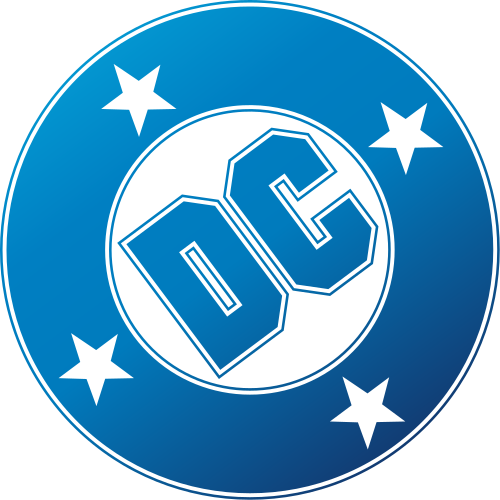
- November Last Issues
- 1984 Comic Debuts
- 1988 Last Issues
- Volumes No Longer in Publication
- Licensed properties
- Star Trek Titles

Star Trek (1984—1988)
- View history
The main DC Comics Star Trek title was published in two volumes, comprising 136 issues, 9 annuals, and a number of special issues. Two volumes were also published based upon Star Trek: the Next Generation , plus several mini-series that linked TOS and TNG.
Original characters in Volume 1 included the bigoted Native American Ensign William Bearclaw, Ensign Nancy Bryce, the bird-like Dr. Chu-Sa, Lt. Commander Maria Morelli, Ensign Elizabeth Sherwood, and the Klingons Konom and Bernie. There were also appearances by Arex and M'Ress, previously seen only in the animated series based on Star Trek. It begins after the events of Star Trek II: The Wrath of Khan and was first published in February 1984.
- 1.1 Annuals
- 1.2 Specials
- 2 Collections
- Star Trek #1
- Star Trek #2
- Star Trek #3
- Star Trek #4
- Star Trek #5
- Star Trek #6
- Star Trek #7
- Star Trek #8
- Star Trek #9
- Star Trek #10
- Star Trek #11
- Star Trek #12
- Star Trek #13
- Star Trek #14
- Star Trek #15
- Star Trek #16
- Star Trek #17
- Star Trek #18
- Star Trek #19
- Star Trek #20
- Star Trek #21
- Star Trek #22
- Star Trek #23
- Star Trek #24
- Star Trek #25
- Star Trek #26
- Star Trek #27
- Star Trek #28
- Star Trek #29
- Star Trek #30
- Star Trek #31
- Star Trek #32
- Star Trek #33
- Star Trek #34
- Star Trek #35
- Star Trek #36
- Star Trek #38
- Star Trek #39
- Star Trek #40
- Star Trek #41
- Star Trek #42
- Star Trek #43
- Star Trek #44
- Star Trek #45
- Star Trek #46
- Star Trek #47
- Star Trek #48
- Star Trek #49
- Star Trek #50
- Star Trek #51
- Star Trek #52
- Star Trek #53
- Star Trek #54
- Star Trek #55
- Star Trek #56
- Star Trek Annual #1 ( 1985 )
- Star Trek Annual #2 ( 1986 )
- Star Trek Annual #3 ( 1988 )
- Star Trek III: The Search for Spock ( 1984 )
- Star Trek IV: The Voyage Home ( 1987 )
- Star Trek V: The Final Frontier ( 1989 )
- Star Trek VI: The Undiscovered Country ( 1991 )
Collections
- Star Trek: The Mirror Universe Saga ( 1991 ) ISBN: 093028996X
- Star Trek: The Best of Star Trek ( 1991 ) ISBN: 1563890097
- Star Trek: To Boldly Go... ( 2005 ) ISBN: 1845760840
- Star Trek: Who Killed Captain Kirk? ( 1993 ) ISBN: 1563890968
- Cover Gallery: Star Trek Vol 1
- Collections from Star Trek Vol 1
- No catalogued images.
- Star Trek: The Next Generation (Volume One)
- Star Trek: The Next Generation (Volume Two)
- Star Trek (DC volume 1) at Memory Beta, the wiki for non-canon Star Trek
- 1 Dead Boy Detectives
- 2 Dead Boy Detectives (Vertigo Universe)
- 3 Batman (Bruce Wayne)

- View history
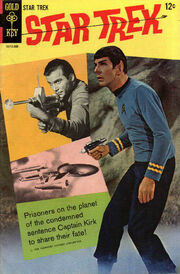
Cover of Gold Key 's "The Devils Isle of Space" ( Issue #2 )
Through a licensing process similar to those granted to create collectibles , novels , and games , Paramount Pictures has granted the rights to market Star Trek merchandise of various sorts through a number of different production and design companies, beginning in July 1967 with a series based on Star Trek: The Original Series .
With the success of the Star Trek films and Star Trek: The Next Generation , the licensing office associated with the productions took stricter control of the franchise 's image. Designers of Star Trek publications were discouraged from creating depictions that varied from the style and details of the franchise, as seen in filmed productions. Previous comics of the 1960s, '70s and early '80s tend to vary from canon more than later series. Since the comics are produced by artists and writers not affiliated with franchise production staff , filmed productions disregard events and situations in them as completely apocryphal.
The Star Trek universe has been displayed in comic book form in many ways throughout its existence. Gold Key Comics , a subsidiary of Western Publishing , which had put out the first original Star Trek novel, Mission to Horatius , first published Star Trek stories, starting in 1967 with a story entitled "K-G, Planet of Death." This company, which was known for publishing comics based on licenses from TV shows and movie properties, produced 61 Star Trek comic books from 1967 to 1979, which focused on all-original adventures of The Original Series crew of the starship USS Enterprise .
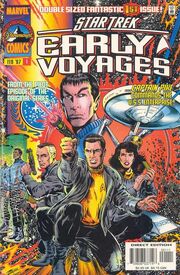
Cover of Marvel 's "Flesh of my Flesh" ( Star Trek: Early Voyages #1)
Since then, many other companies have published different series of Star Trek comic books, including Marvel and DC at multiple intervals. Many are simply adaptations of episodes and movies, while others are brand-new stories involving existing Trek characters, and still others have introduced completely new characters and settings. One of the best examples of the latter is Marvel Comics' series Star Trek: Early Voyages , which featured adventures of Captain Pike 's crew on the original Enterprise before Captain Kirk took command.
- 1 Canonicity of Star Trek comics
- 2 Gold Key (1967-1979)
- 3 British strips (1969-1973)
- 4 Peter Pan Records (1975-1979)
- 5 Marvel Comics v1 (1979-1982)
- 6 McDonald's (1979)
- 7 Newspaper comic strip (1979-1983)
- 8 DC Comics v1 (1984-1988)
- 9 DC Comics v2 (1989-1995)
- 10 Malibu Comics (1993-1995)
- 11 Marvel Comics v2 (1995-1998)
- 12 WildStorm Comics (1999-2001)
- 13 Tokyopop (2006-2009)
- 14 IDW Publishing (2007-current)
- 15 Wired magazine (2009)
- 16 See also
- 17 External links
Canonicity of Star Trek comics [ ]
While many comic book runs of the Star Trek universe have provided interesting story arcs and situations that would be difficult to show on television, all stories are considered to be non- canon .
In 2012 , in an interview with Trekmovie.com, producer and writer Roberto Orci , pressed by the editor Anthony Pascale to declare that all of the recent Star Trek comics which he had overseen (such as Star Trek: Countdown ) were canon until contradicted by onscreen sources, indicated that he agreed with that proposal. [1] , although he would later step back from that view, saying " [I] have said a million times that we cant determine what is canon. [On] this day, [I] said something else. 'consistency is the hobgoblin of little minds.' " [2]
Gold Key (1967-1979) [ ]
Gold Key Comics published 61 issues from July 1967 to February 1979 . The comics focused on the USS Enterprise during James T. Kirk 's first five-year mission . A 62nd issue was written and partially illustrated, but was only published in 2020, when Eaglemoss published it in the Star Trek Graphic Novel Collection .
Those were reprinted several times:
- Golden Press : " Star Trek: The Enterprise Logs " (4 volumes – 1976 - 1977 ); in addition to reprints, these volumes also contained four original tales that did not appear in the 61 issues.
- Checker Books : " Star Trek: The Key Collection " (6 volumes – 2004 - 2007 )
- World Distributors Limited : Star Trek Annuals (UK 1969 / 1986 )
- Gold Key: Dynabrite #11357 (reprinted issues 33 and 41)
- Gold Key: Dynabrite #11358 (reprinted issues 36 and 44)
- Gold Key: Dan Curtis Give-Aways #2 (reprinted excerpt of issue 14)
- Gold Key: Dan Curtis Give-Aways #6 (reprinted excerpt of issue 13)
- Star Trek View-Master (reprinted issue 1)
- Mighty TV Comic #1292-1352 (reprinted issue #1 [#1292-1303]; #4 [#1304-1316]; #5 [1317-1329]; #6 [#1330-1345]; and first half of #7 [#1346-1352])
- TV Comic #1353-1381 (reprinted second half of issue #7 [#1353-1358]; #8 [#1359-1371]; and #9 in abridged format [#1372-1381])
- Star Trek Hardcover Annuals (reprinted issues #1-3 [1969]; #4-6 [1970]; #7-9 [1972]; #11-13 [1973]; #14-16 [1974]; #17, 21 & 24 [1975]; #27 & 30 [1976]; #10 & 34 [1977]; #38-39 [1978]; #36 & 40 [1979]; #54-56 [1980]; #59 & 61 [1983]; #27 & 40 [1986])
- Star Trek Special (reprinted issues #47-48)
- Star Trek Television Picture Story Book (reprinted issues #1 & 10)
- Star Trek Comic Album (reprinted issues #2-3)
- Star Trek Comic Album (reprinted issues #7-9)
- Star Trek Picture Book (reprinted issue #6, issued as premium gift at Total gas stations in 1975)
- Star Trek Mighty Midget (insert in Mighty TV Comic #1293, reprinted half of issue #26)
- Star Trek Winter Special (reprinted #2-3)
British strips (1969-1973) [ ]
Concurrent with the Gold Key strips, a series of weekly comic strips based on Star Trek was released in the United Kingdom. Published in the pages of Joe 90: Top Secret , TV21 , and Valiant , these strips appeared as two- and three-page spreads in magazines printing Star Trek and other adventure-based titles. 256 issues were published over the course of five years, with additional stories running in one Joe 90 annual, three TV21 annuals, a Valiant Super Special, two TV Comic annuals, and an issue of Radio Times magazine.
Peter Pan Records (1975-1979) [ ]
From 1975 through 1979, Peter Pan Records (and Power Records, a division thereof) released eleven stories. Six of these stories were accompanied by comic books, and some of the stories reference the continuity of both Star Trek: The Original Series and Star Trek: The Animated Series . Peter Pan Records released the stories on a total of 23 record sets, some featuring one story, others featuring as many as six on one release.
Marvel Comics v1 (1979-1982) [ ]
Marvel Comics took over the franchise in 1979 and published a series of comics based on the crew of the USS Enterprise in the 2270s after the events of Star Trek: The Motion Picture .
- Marvel Comics Super Special #15: Star Trek: The Motion Picture ( 1979 )
- Star Trek : 18 issues ( 1980 - 1981 )
McDonald's (1979) [ ]
To celebrate the release of Star Trek: The Motion Picture , McDonald's released its first-ever set of Happy Meal Boxes, featuring comic strips adapting scenes from the film, on six separate boxes. Additional strips were included in special Star Trek Communicator toys included with the Happy Meals.
Newspaper comic strip (1979-1983) [ ]
Around the same time as Marvel Comics was publishing its comic books, a newspaper comic strip based on Star Trek appeared. Like the Marvel publications it, too, told of the adventures of the USS Enterprise after the events of Star Trek: The Motion Picture . It lasted four years and consisted of twenty story arcs.
DC Comics v1 (1984-1988) [ ]
DC Comics published a series of comics based on TOS , the movies , and TNG .
- " The Mirror Universe Saga " (Issues #9-16, 1984)
- " Who Killed Captain Kirk? " (Issues #48-55, 1988)
- Movie special – Star Trek III: The Search for Spock
- Movie special – Star Trek IV: The Voyage Home
- Who's Who in Star Trek : two issues ( 1987 )
- Star Trek: The Next Generation (DC volume 1) : Six issue mini-series ( 1988 )
DC Comics v2 (1989-1995) [ ]
After stopping the publication in 1988 , DC Comics renewed the license in 1989 , publishing comics based on TOS ( 2260s - 2280s ) and TNG .
- " Tests of Courage " (issues #35-40)
- " Debt of Honor " (graphic novel)
- " The Ashes of Eden " (graphic novel)
- Star Trek: The Modala Imperative (four issues, 1991)
- Movie special – Star Trek V: The Final Frontier
- Movie special – Star Trek VI: The Undiscovered Country
- Movie special – Star Trek Generations
- " The Star Lost " (issues #20-24)
- Star Trek: The Next Generation - Ill Wind (four issue mini-series)
- Star Trek: The Next Generation - Shadowheart (four issue mini-series)
- Star Trek: The Next Generation - The Modala Imperative (four issues, 1991)
- The Landmark Crossover (four issue mini-series, with Malibu Comics )
Malibu Comics (1993-1995) [ ]
Concurrent with DC's license for TOS and TNG comics, Malibu Comics acquired the rights to publish Star Trek: Deep Space Nine com ics.
- Star Trek: Deep Space Nine : 32 issues, two annuals
- The Landmark Crossover (four issue mini-series, with DC Comics )
- Star Trek: Deep Space Nine - Hearts and Minds (four issue mini-series)
- Star Trek: Deep Space Nine - The Maquis: Soldier of Peace (three issue mini-series)
- One-shots: " Terok Nor ", " Worf Special ", " Lightstorm ", " Special ", " Blood & Honor ", " The Rules of Diplomacy ", " Hostage Situation "
Malibu had also apparently obtained rights to produce Voyager comics, but stopped comic production (due to a buyout from Marvel) before any issues were released.
Marvel Comics v2 (1995-1998) [ ]
Done under the imprint "Marvel Presents Paramount Comics", Marvel had rights to produce comics based on all the existing Star Trek properties at the time.
- Star Trek: Untold Voyages : five monthly issues (based on TOS in the 2270s )
- Star Trek Unlimited : 10 monthly issues (based on TOS and TNG)
- Star Trek: Deep Space Nine : 15 monthly issues
- " Splashdown " (four issue mini-series)
- Star Trek: Early Voyages : 17 monthly issues based on Pike 's era
- Star Trek: Starfleet Academy : 19 monthly issues
- One-shots : " Star Trek: Operation Assimilation ", Star Trek: Mirror, Mirror : "Fragile Glass" , " Star Trek: First Contact ", Star Trek - X-Men : "Star TreX" , Star Trek - X-Men : "Second Contact" , " The Enemy of My Enemy ", and Star Trek: Telepathy War : " Reality's End ".
WildStorm Comics (1999-2001) [ ]
DC Comics, through their WildStorm Comics imprint, obtained rights to the Star Trek comics for the third (and to date, final) time. Again published as "Paramount Comics", WildStorm limited their releases to single issues and limited series.
- " All of Me "
- " Enter the Wolves "
- Star Trek: The Next Generation - Perchance to Dream (four issue mini-series)
- " Embrace the Wolf "
- Star Trek: The Next Generation - The Killing Shadows (four issue mini-series)
- " The Gorn Crisis "
- " Forgiveness "
- DS9 : Star Trek: Deep Space Nine - N-Vector (four issue mini-series)
- " False Colors "
- " Elite Force "
- " Avalon Rising "
- Star Trek: Voyager - Planet Killer (three issue mini-series)
- New Frontier : " Double Time "
- " Star Trek: Special "
- Star Trek: Divided We Fall (four issue TNG/DS9 crossover)
Tokyopop (2006-2009) [ ]
Tokyopop published Star Trek: The Manga and Star Trek: The Next Generation - The Manga . The first volume of this series, titled " Shinsei Shinsei ", was a collection of five Star Trek manga stories published in August and September . The stories are based in the TOS-era. A second TOS-based five-story volume, " Kakan ni Shinkou ", was released in 2007 with a third following mid- 2008 . The TNG-era series was released in April 2009 .
- Volume 1: " Shinsei Shinsei "
- Volume 2: " Kakan ni Shinkou "
- Volume 3: " Uchu "
- Volume 1: " Boukenshin "
IDW Publishing (2007-current) [ ]
IDW Publishing – publishers of comics based on the CSI , Doctor Who , and 24 TV series – reached a deal with CBS/Paramount to release new Star Trek comics. IDW initially limited their releases to mini-series until the ongoing series based on the 2009 film.
The first book, a six-issue mini-series based on The Next Generation , was released in January 2007 . A second, a TOS-era Klingon-based five-issue mini followed in April 2007 , [3] (X) [4] with a "Star Trek: Year Four" miniseries following in July 2007 and an "Alien Spotlight" miniseries starting in November 2007 . [5] (X) [6]
- Star Trek: Klingons - Blood Will Tell
- Star Trek: Year Four
- Star Trek: Year Four - The Enterprise Experiment
- Star Trek: Assignment: Earth
- Star Trek: Romulans - The Hollow Crown
- Star Trek: Romulans - Schism
- Star Trek: Crew
- Star Trek: Mission's End
- Star Trek II: The Wrath of Khan
- Star Trek: Leonard McCoy, Frontier Doctor
- Star Trek: Burden of Knowledge
- Star Trek: Khan - Ruling in Hell
- Star Trek: Infestation (crossover with other IDW titles)
- Star Trek - Legion of Super-Heroes (crossover with DC Comics )
- Star Trek: Strange New Worlds (photonovel)
- Star Trek: Harlan Ellison's The City on the Edge of Forever
- Star Trek - Planet of the Apes: The Primate Directive (crossover with Planet of the Apes )
- Star Trek: New Visions (photonovels)
- Star Trek: Year Five
- Star Trek: Hell's Mirror
- Star Trek: The Motion Picture - Echoes
- Star Trek vs. Transformers (crossover with Transformers )
- Star Trek: The Animated Celebration Presents The Scheimer Barrier
- Star Trek: The Next Generation - The Space Between
- Star Trek: The Next Generation - Intelligence Gathering
- Star Trek: The Last Generation
- Star Trek: The Next Generation - Ghosts
- Star Trek: The Next Generation - Doctor Who: Assimilation² (crossover with Doctor Who )
- Star Trek: The Next Generation - Hive
- Star Trek: Deviations
- Star Trek: The Next Generation - Mirror Broken
- Star Trek: The Next Generation - Through the Mirror
- Star Trek: The Next Generation - Terra Incognita
- Star Trek: The Next Generation - IDW 20/20
- Star Trek: Sky's the Limit
- Star Trek: The Mirror War
- Star Trek: Holo-ween
- Star Trek: Deep Space Nine - Fool's Gold
- Star Trek: Deep Space Nine - Too Long a Sacrifice
- Star Trek: Deep Space Nine - The Dog of War
- Star Trek: Voyager - Mirrors and Smoke
- Star Trek: Voyager - Seven's Reckoning
- Star Trek: Discovery - The Light of Kahless
- Star Trek: Discovery Annual 2018
- Star Trek: Discovery - Succession
- Star Trek: Discovery - Captain Saru
- Star Trek: Discovery - Aftermath
- Star Trek: Discovery - Adventures in the 32nd Century
- Star Trek: Picard - Countdown
- Star Trek: Picard - Stargazer
- Star Trek: Lower Decks
- Star Trek: Lower Decks: Warp Your Own Way
- Star Trek: Strange New Worlds - The Illyrian Enigma
- Star Trek: Strange New Worlds - The Scorpius Run
- Star Trek: Countdown
- Star Trek: Spock: Reflections
- Star Trek: Nero
- Star Trek: The Official Motion Picture Adaptation
- Star Trek: Ongoing
- Star Trek: Countdown to Darkness
- Star Trek: Khan
- Star Trek: Starfleet Academy
- Star Trek: Boldly Go
- Star Trek - Green Lantern: The Spectrum War (crossover with DC Comics)
- Star Trek: Manifest Destiny
- Star Trek - Green Lantern: Stranger Worlds (crossover with DC Comics)
- Star Trek: New Frontier - Turnaround
- Star Trek: Resurgence
- Star Trek: Defiant
- Star Trek: Day of Blood
- Star Trek: Picard's Academy
- Star Trek: Sons of Star Trek
- Star Trek: Alien Spotlight (volumes I and II)
- Star Trek: Mirror Images
- Star Trek: Captain's Log
- Star Trek Special: Flesh and Stone
- Star Trek: Waypoint
- Star Trek: Waypoint Special
- Star Trek: Waypoint Special 2019
- Star Trek: The Q Conflict
- Star Trek: Aliens
- Star Trek #400
- Star Trek Annual (2023)
- Star Trek Archives
- Star Trek Omnibus
- Star Trek Classics
Wired magazine (2009) [ ]
The September 2009 issue of Wired magazine, issue 17.05, contained an online mini comic tied in with the first J.J. Abrams Star Trek film. The comic is available online. [7]
- When Worlds Collide: Spock Confronts the Ultimate Challenge
See also [ ]
- Star Trek: The Complete Comic Book Collection
- Star Trek Graphic Novel Collection
External links [ ]
- Comic at Memory Beta , the wiki for licensed Star Trek works
- Comic book at Wikipedia
- Star Trek Comics Checklist
- Wixiban's Star Trek Collectables Portal - Star Trek Comics and Graphic Novels index
- 2 ISS Enterprise (NCC-1701)
Previous Home Next
Star Trek DC Comics first monthly series
All issues of the first monthly Star Trek series and the first six-issue Star Trek: The Next Generation mini-series were distributed via direct market and at newsstands . You can view all the DC first series price and logo variant covers (a work in progress).

#1 Feb 1984 The wormhole connection Kirk is given command of the Enterprise again and assigned to investigate the destruction of a Federation starship by Klingons. Kirk, Saavik, and an ensign discover that the Klingons have built a space station on the other side of a wormhole. Stardate 8141.5 The first story in this series takes place after the events of Star Trek II: The Wrath of Khan . Spock is dead, and Saavik has replaced him as science officer. Part one of a four-part story arc. Writer: Mike W. Barr Penciller: Tom Sutton Inker: Ricardo Villagran Cover artist: George Perez

#2 Mar 1984 The only good Klingon Saavik provides a diversion while Kirk and Ensign Bryce sabotage the Klingon station. After escaping back to the Enterprise, the crew learns that the Klingons have declared war on the Federation. Stardate 8149.2 Part two of a four-part story arc. Writer: Mike W. Barr Penciller: Tom Sutton Inker: Ricardo Villagran Cover artist: George Perez

#3 Apr 1984 Errand of war The Federation-Klingon war is being orchestrated by Excalbians ( The Savage Curtain ). Defying orders, Kirk heads for Organia where he finds the planet shrouded in a black field that absorbs all energy. After a brief battle with the Klingons, Kirk captures his old adversary, Captain Kor ( Errand of Mercy ), and an Excalbian appears aboard Enterprise. Stardate 8150.7 Part three of a four-part story arc. Writer: Mike W. Barr Penciller: Tom Sutton Inker: Ricardo Villagran Cover artist: George Perez

#4 May 1984 Deadly allies Yarnek, the Excalbian, tells Kirk that his first investigation of good and evil was inconclusive. The Excalbians have engineered the entrapment of Organia and a Federation-Klingon war. Kor and his crew help the Enterprise penetrate the black field. Kirk convinces the Excalbian to join the play directly by taking on the Organians. The Excalbians and Organians disappear. The Federation and the Klingon Empire are free to chart their own course. Stardate 8151.7 Conclusion of a four-part story arc. Writer: Mike W. Barr Penciller: Tom Sutton Inker: Ricardo Villagran Cover artists: Sutton, Villagran

#5 Jun 1984 Mortal gods A former student of Kirk's is the only survivor of a battle with a Klingon ship. He lands on a primitive planet and becomes a god. Kirk and his crew must minimize the impact without further violations of the Prime Directive. Stardate 8163.5 Writer: Mike W. Barr Penciller: Tom Sutton Inker: Sal Amendola Cover artists: Sutton, Amendola

#6 Jul 1984 Who is Enigma? Peace talks between the Federation and the Klingon Empire are threatened by Enigma, a shape-shifting revolutionary, who is determined to kill Ambassador Robert Fox ( A Taste of Armageddon ). Stardate 8173.5 Writer: Mike W. Barr Penciller: Tom Sutton Inker: Ricardo Villagran Cover artists: Sutton, Sal Amendola
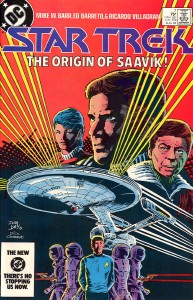
#7 Aug 1984 Pon Farr Saavik enters pon farr. She tells Kirk and McCoy how she met Spock and about her bonding with Xon. Kirk directs the Enterprise to Vulcan. On arrival, Saavik learns that Xon is on a secret mission. She obtains information of his whereabouts and takes a ship to the rim of the galaxy, with the Enterprise close behind. Stardate 8180.1 Part one of a two-part story arc, the origin of Saavik. Writer: Mike W. Barr Penciller: Eduardo Barreto Inker: Ricardo Villagran Cover artists: Dan Day, Dick Giordano
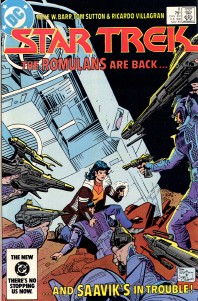
#8 Nov 1984 Blood fever Saavik finds Xon, who is masquerading as a Romulan to learn the secrets of a bioengineering technique which threatens the Federation. The Romulans discover Xon's treachery and begin interrogating him. The Enterprise finds Saavik and frees Xon, then lures the Romulans into the energy barrier at the galaxy's rim. Stardate 8185.35 Conclusion of a two-part story arc. Star Trek III: The Search for Spock is the next episode in continuity. Writer: Mike W. Barr Penciller: Tom Sutton Inker: Ricardo Villagran Cover artists: Sutton, Joe Orlando
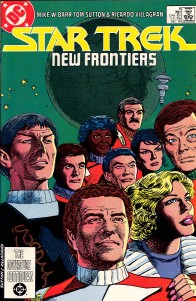
#9 Dec 1984 Promises to keep After visiting with Spock, Kirk and his colleagues decide to return to Earth aboard the Klingon bird-of-prey. At Space Station Regula I, they ponder their future and attend a memorial service for Davis Marcus ( Star Trek II: The Wrath of Khan ). Meanwhile, in another universe, Captain Kirk ( Mirror, Mirror ) destroys Space Station Regula I with Dr. Carol Marcus ( Star Trek II: The Wrath of Khan ) aboard, after obtaining vital data from her. The Empire is preparing to conquer another universe. Stardate 8215.5 Part one of an eight-part story arc, New frontiers, also known as the Mirror universe saga. This story arc was scripted before Star Trek IV: The Voyage Home . Writer: Mike W. Barr Penciller: Tom Sutton Inker: Ricardo Villagran Cover artists: Sutton, Villagran
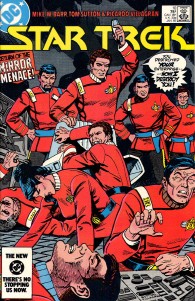
#10 Jan 1985 Double image The Empire's Enterprise breaks through into Federation space and heads for Regula I. Captain Styles ( Star Trek III: The Search for Spock ) is headed there also, to pick up Kirk and his crew. Taking the bird-of-prey in tow, Excelsior leaves for Earth. The Enterprise attacks a starship and continues on towards Regula I. The Excelsior returns to engage the intruder, but is boarded and captured by the Empire. Stardate 8216.4 Part two of an eight-part story arc. Writer: Mike W. Barr Penciller: Tom Sutton Inker: Ricardo Villagran Cover artists: Sutton, Villagran
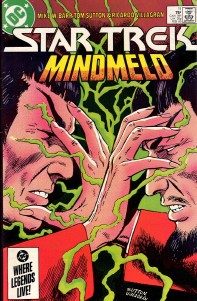
#11 Feb 1985 Deadly reflection The Empire's Kirk sends Spock to Vulcan to retrieve the Federation's Spock. Kirk and his crew escape from Excelsior to the Enterprise, where they find Marlena Moreau ( Mirror, Mirror ) and take over the ship. On Vulcan, Spock finds Spock still recovering and mind-melds with him. Excelsior pursues Enterprise. After a brief battle, the Empire's Kirk starts the auto-destruct sequence aboard the Enterprise and Kirk can't stop it. Stardate 8217.2 Part three of an eight-part story arc. Writer: Mike W. Barr Penciller: Tom Sutton Inker: Ricardo Villagran Cover artists: Sutton, Villagran
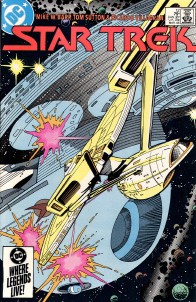
#12 Mar 1985 The Tantalus trap The Empire's Spock and his Federation counterpart engage in a mind-meld duel until one is defeated. Before the Enterprise self-destructs, Scotty and Saavik manage to separate the saucer section from the warp drive. Using the Tantalus field, Kirk disables Excelsior and captures his Empire counterpart. Scotty and Saavik repair Excelsior and modify the transwarp engines to travel into Empire space. Kirk plans to stop the Empire's invasion. As they leave, both Spocks returns from Vulcan. Stardate 8217.8 Part four of an eight-part story arc. Writer: Mike W. Barr Penciller: Tom Sutton Inker: Ricardo Villagran Cover artists: Sutton, Villagran
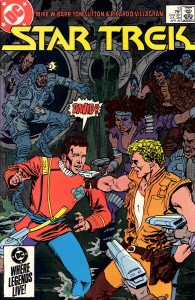
#13 Apr 1985 Masquerade The Federation's Kirk meets with David Marcus and other leaders of the underground fighting to free themselves from Empire rule. Both Spocks arrive in the alternate universe and join Kirk on Excelsior. The Empire's Spock has lost his hatred and has agreed to help overthrow the Empire. Kirk has convinced the Empire to let him lead an invasion fleet to his own universe, where he will turn on them. A spy learns of Kirk's plans and the invasion fleet turns on Excelsior. Stardate 8220.3 Part five of an eight-part story arc. Writer: Mike W. Barr Penciller: Tom Sutton Inker: Ricardo Villagran Cover artist:
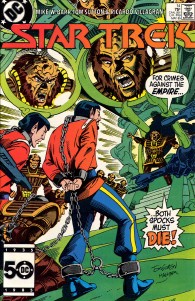
#14 May 1985 Behind enemy lines His plan to sabotage the Empire invasion discovered, Kirk follows David Marcus' suggestion to free scientists from a prison planet to assist with the rebellion. Kirk sends both Spocks and Konom, a Klingon serving aboard Excelsior, to the Klingon homeworld to seek an alliance. Stardate 8221.6 Part six of an eight-part story arc. Writer: Mike W. Barr Penciller: Tom Sutton Inker: Ricardo Villagran Cover artists: Sutton, Magyar ?
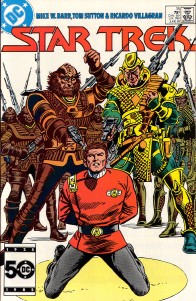
#15 Jun 1985 The beginning of the end Kirk builds a shaky alliance with the Klingons and Romulans in the Empire's universe. Using a device that disables transtator-based technology, most of the Empire's fleet is defeated. Kirk, in Excelsior, fights one last battle against the Empire's Excelsior-class starship. Kirk turns over the defeated Empire fleet to David Marcus to continue the fight. The Empire's Kirk escapes in a shuttle, but is caught by an Empire starship. Excelsior returns home. Stardate 8223.4 Part seven of an eight-part story arc. Writer: Mike W. Barr Penciller: Tom Sutton Inker: Ricardo Villagran Cover artist:
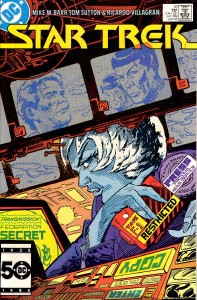
#16 Jul 1985 Homecoming On arrival in his own universe, Kirk and his crew are arrested by Captain Styles. To plead his case, Kirk secretly transmits the Excelsior's log on an open channel. The broadcast is picked up by the press and he returns home a hero. Kirk is given command of Excelsior and Spock takes command of science vessel Surak. Stardate 8218.4 Conclusion of an eight-part story arc. Writer: Mike W. Barr Penciller: Tom Sutton Inker: Ricardo Villagran Cover artist:
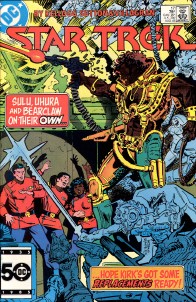
#17 Aug 1985 The D'Artagnan three Sulu, Uhura, and Bearclaw investigate a space station for evidence of smuggling while Kirk, in Excelsior, tracks down the source of smuggled dilithium crystals. Sulu, in his first command, learns that the smugglers are also slavers, and engineers their capture. Stardate 8263.5 Writer: L.B. Kellogg Penciller: Tom Sutton Inker: Ricardo Villagran Cover artists: Sutton, Janson
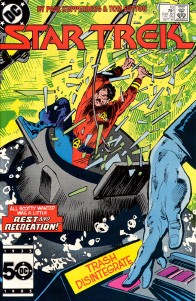
#18 Sep 1985 Rest and recreation On shore leave, Scotty stumbles onto a drug processing operation which threatens the safety of a starbase. With the help of a Starfleet cadet, he manages to put a stop to the drug operation. Stardate 8293.6 Writer: Paul Kupperberg Penciller: Tom Sutton Inker: Ricardo Villagran Cover artist:
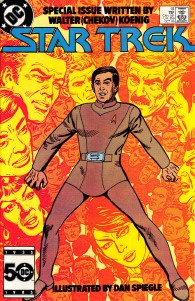
#19 Oct 1985 Chekov's choice Chekov incites the crew of the Enterprise to mutiny while the ship is out of control and on a collision course for an asteroid. Stardate 6714.3 This story is set between Star Trek: The Motion Picture and Star Trek II: The Wrath of Khan . Writer: Walter Koenig Artist: Dan Spiegle Cover artists: Sutton, Villagran
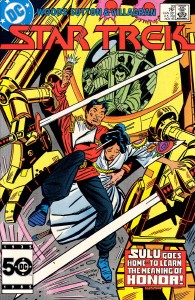
#20 Nov 1985 Giri Sulu attends a family wedding and winds up in a battle for his life to prevent a murder. Stardate 8293.6 Wenonah Woods is a pseudonym of Laurie Sutton. Writer: Wenonah Woods Penciller: Tom Sutton Inker: Ricardo Villagran Cover artists: Sutton, Wray
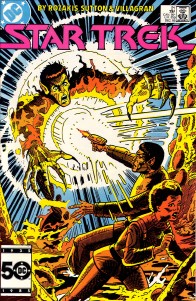
#21 Dec 1985 Dreamworld Spock and the crew of the Surak arrive at an unexplored planet. Beaming down with two crewmembers, Spock finds himself alone, in a dream. He must find his way out of the dream and save the rest of his landing party. Stardate 8293.6 Writer: Bob Rozakis Penciller: Tom Sutton Inker: Ricardo Villagran Cover artist:
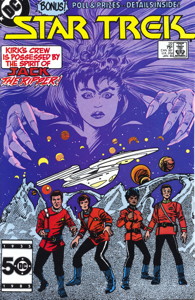
#22 Jan 1986 The wolf Redjac ( Wolf in the Fold ) returns to spread fear and murder aboard Excelsior, and to take revenge on Kirk. Lured to a planet whose inhabitants worship Redjac, Kirk and his landing party discover that Redjac inhabits the body of one of their own. Stardate 8878.1 Part one of a two-part story arc, Wolf on the prowl. Writer: Tony Isabella Penciller: Tom Sutton Inker: Ricardo Villagran Cover artist:
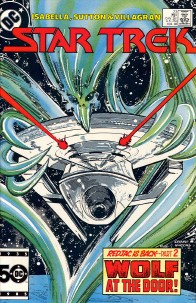
#23 Feb 1986 Wolf at the door Redjac kills several crewmembers and taunts Kirk unmercifully. Scotty manages to adjust the shields to prevent Redjac from entering the ship and with Saavik's help, creates a wormhole which draws Redjac into another universe. Stardate 8818.4 Conclusion of a two-part story arc. Writer: Tony Isabella Penciller: Tom Sutton Inker: Ricardo Villagran Cover artists: Cowan, Janson
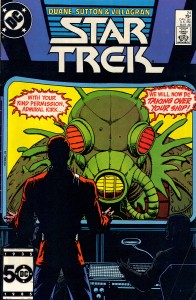
#24 Mar 1986 Double blind The Ajir demand that Kirk surrender Excelsior. Since the Ajir ship has no shields and very little power, Kirk surrenders in order to learn what these beings are up to. They claim to be a conquering race but turn out to be more like children. Then the Grond show up. Part one of a two-part story arc. Writer: Diane Duane Penciller: Tom Sutton Inker: Ricardo Villagran Cover artist: Jim Starlin
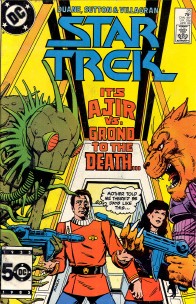
#25 Apr 1986 Double blind Kirk surrenders to the Grond also. He learns that both the Ajir and the Grond have adopted an aggressive posture for protection, but their homeworlds are economically depressed. Kirk convinces them that the Federation can help and they return Excelsior to the Federation. Stardate 8890.1 Conclusion of a two-part story arc. Writer: Diane Duane Penciller: Tom Sutton Inker: Ricardo Villagran Cover artist: Jim Starlin
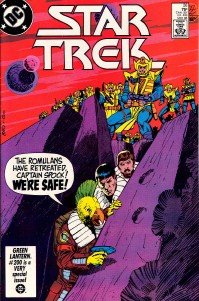
#26 May 1986 The trouble with transporters Exploring a newly discovered planet, Spock and the Surak encounter transporter problems and a Romulan attack on a landing party. Stardate 8892.3 Writer: Bob Rozakis Artist: Tom Sutton Cover artists: Ricardo Villagran; Brozowski, Gio ?
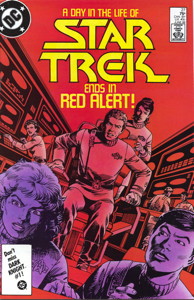
#27 Jun 1986 Around the clock A day in the life of Excelsior's crew. Stardate 8988.3 Writer: Robert Greenberger Penciller: Tom Sutton Inker: Ricardo Villagran Cover artists: Brozowski, Villagran, Zaffino
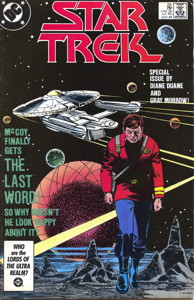
#28 Jul 1986 The last word After a crewman falls into a coma following the death of a close friend, McCoy can't find any physical cause. Since he carried Spock's marbles for a while, he tries to mind-meld with his patient and succeeds in bringing him out of the coma. Stardate 8899.7 Writer: Diane Duane Artist: Gray Morrow Cover artists: Brozowski, Villagran
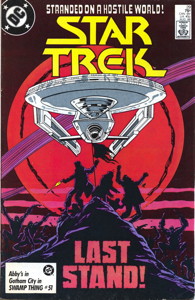
#29 Aug 1986 The trouble with Bearclaw While Kirk is inundated with Excelsior paperwork, an away team of mixed race gets into trouble on a planetary survey. Bearclaw is insubordinate to his alien colleagues, but manages to keep everyone alive. Stardate 8901.1 Writer: Tony Isabella Penciller: Tom Sutton Inker: Ricardo Villagran Cover artist:
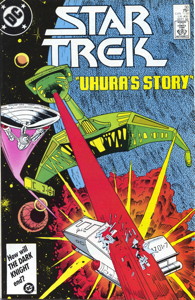
#30 Sep 1986 Uhura's story Flashback to Uhura's first mission after assignment to the Enterprise. Uhura commandeers a shuttle to rescue Kirk and his landing party from Klingons. Stardate 9142.50 and 1297.80 Writer: Paul Kupperberg Penciller: Carmine Infantino Inker: Ricardo Villagran Cover artist:
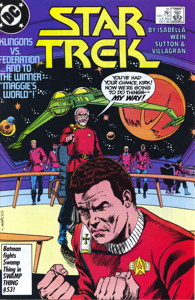
#31 Oct 1986 Maggie's world Excelsior escorts a Federation ambassador to a planet under development by Federation and Klingon interests. The natives are leaning toward alignment with the Klingons. When Excelsior arrives, a Federation mining operation is sabotaged. Stardate 8903.6 Part one of a two-part story arc. Writers: Tony Isabella, Len Wein Penciller: Tom Sutton Inker: Ricardo Villagran Cover artists: Brozowski, Marcos
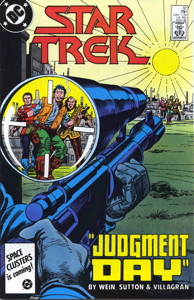
#32 Nov 1986 Judgement day The governor of Maggie's world learns who sabotaged the Federation mining facility and with Excelsior's help, obtains proof. The natives vote for Klingon jurisdiction, but Kirk and the governor secure concessions for the Federation. Stardate 8904.6 Conclusion of a two-part story arc. Writer: Len Wein Penciller: Tom Sutton Inker: Ricardo Villagran Cover artist:
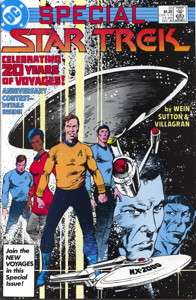
#33 Dec 1986 Vicious circle After being hurled back to 1960's Earth ( Tomorrow Is Yesterday ), the Enterprise attempts to return home, but overshoots by 20 years. Meeting Excelsior and their older selves, time ripples begin to tear apart the universe. The Guardian of Forever ( The City on the Edge of Forever ) is their only hope. Stardate 3114.1 and 8906.3 20th anniversary issue. Writer: Len Wein Penciller: Tom Sutton Inker: Ricardo Villagran Cover artist: Bingham
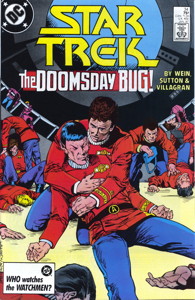
#34 Jan 1987 Death ship Responding to an emergency signal from the Surak, Excelsior finds the entire crew dead except for Spock. The ship's log reveals that an Andorian carried some kind of plague aboard. Meanwhile, diplomatic relations with the Romulans have broken down and Excelsior must pursue a shuttle with the Andorian aboard, into the Romulan neutral zone. Stardate 8906.3 Part one of a three-part story arc, the doomsday bug. Writer: Len Wein Penciller: Tom Sutton Inker: Ricardo Villagran Cover artists: Brozowski, Smith
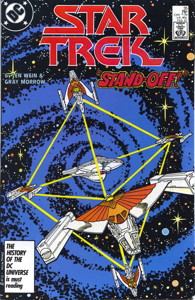
#35 Feb 1987 Stand off Excelsior is in a stand-off with Romulan warships while Kirk tries to convince their commander that a plague carrier threatens the Empire. When Romulan crewmen begin dying, one of the Romulan ships breaks formation, heading for the homeworld. The other Romulans and Excelsior pursue. The Federation sends Captain Styles to bring Kirk and Excelsior back to Federation space. Stardate 8907.5 Part two of a three-part story arc. Writer: Len Wein Artist: Gray Morrow Cover artists: Brozowski, Montano
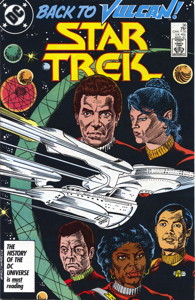
#36 Mar 1987 The apocalypse scenario Scotty uses a modified transporter to filter the doomsday bug from the Romulans. Spock's body recovers from the effects of the plague but his mind is in chaos. Kirk and his closest friends take a bird-of-prey to Vulcan to get help. Stardate 8908.3 Conclusion of a three-part story arc. This story restores continuity for Star Trek IV: The Voyage Home . Writer: Len Wein Artist: Gray Morrow Cover artists: Brozowski, Marcos
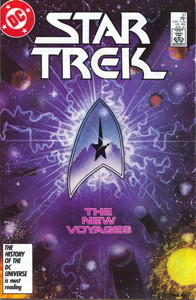
#37 Apr 1987 Choices Following Kirk's demotion to captain and reassignment to the Enterprise, his fellow officers consider their future and rejoin him for new adventures. A religious fanatic attempts to destroy the newly refitted Enterprise, but is thwarted by Spock. Stardate 8925.2 ST:TAS characters Lt. Arex ( One of Our Planets is Missing ) and Lt. M'Ress ( The Survivor ) make the first of several appearances in this series (#37, #39, #40, #46-55). M'Ress has the hots for Sulu. Writer: Len Wein Penciller: Curt Swan Inker: Pablo Marcos Cover artist: Wray
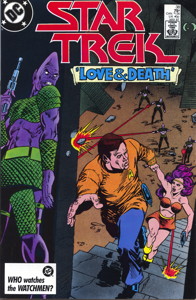
#38 May 1987 The Argon affair While the Enterprise undergoes repairs following a battle with Argonian pirates, Kirk saves a beautiful young woman from pirates. On board the Enterprise, she tries to sabotage the ship and is revealed as an Argonian spy. Stardate 3847.5 Writer: Michael Fleisher Penciller: Adam Kubert Inker: Ricardo Villagran Cover artist:
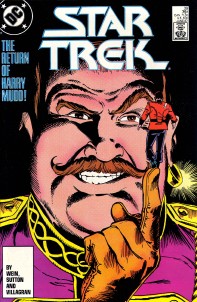
#39 Jun 1987 When you wish upon a star Trapped by an unknown force, the Enterprise is taken to an unexplored planet. A landing party led by Spock attempts to transport to the surface, but Kirk, McCoy, and Scotty are transported with them. They find themselves on some kind of amusement planet ruled by Harry Mudd ( Mudd's Women ). Stardate 8931.2 Part one of a two-part story arc, the return of Mudd. Writer: Len Wein Penciller: Tom Sutton Inker: Ricardo Villagran Cover artist:
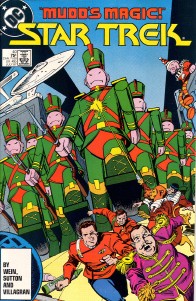
#40 Jul 1987 Mudd's magic Mudd explains to Kirk that he landed on the amusement planet by accident and wished for help getting off-planet. The Enterprise is the answer to his wish. The landing party learns that the planet is really a nursery. Spock mind-melds with the artifact controlling the planet and the Enterprise is freed. Stardate 8932.3 Conclusion of a two-part story arc. Writer: Len Wein Penciller: Tom Sutton Inker: Ricardo Villagran Cover artist:
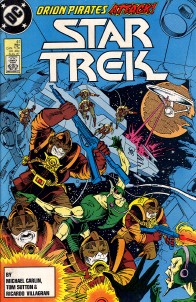
#41 Aug 1987 What goes around The Enterprise responds to a distress call from a merchant ship under attack by Orion pirates. The pirates have hostages aboard their ship, and the merchant ship in tow, when the Enterprise arrives. Thanks to another miracle from Scotty, the hostages are rescued and the pirates captured. Stardate 8950.4 Writer: Michael Carlin Penciller: Tom Sutton Inker: Ricardo Villagran Cover artists: Brozowski, Lewis
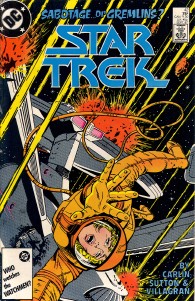
#42 Sep 1987 The corbomite effect The Enterprise is beset by numerous glitches. Scotty insists that gremlins are responsible and Kirk orders him to take a few days off. Scotty manages to rid the Enterprise of the gremlins in spite of the fact that no one believes him. Stardate 8953.7 Writer: Michael Carlin Penciller: Tom Sutton Inker: Ricardo Villagran Cover artists: Brozowski, Lewis
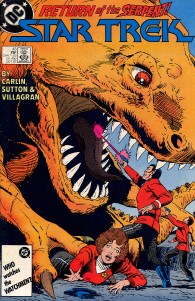
#43 Oct 1987 Paradise lost Returning to Gamma Trianguli VI ( The Apple ) after 20 years, Kirk finds a desolate world and a despotic ruler who takes the landing party prisoner. The landing party manages to escape, but on board the Enterprise, no one is responding. Stardate 8954.8 Part one of a three-part story arc, the return of the serpent. Writer: Michael Carlin Penciller: Tom Sutton Inker: Ricardo Villagran Cover artists: Brozowski, Lewis
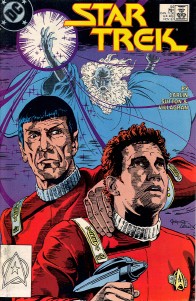
#44 Nov 1987 Past perfect The followers of Vaal capture Kirk and his landing party for a sacrifice. They use powers taught by Vaal to draw the Enterprise out of orbit, to the surface. Spock convinces them to stop by offering to restore Vaal. Scotty sends a team of storm-troopers to free the landing party. Spock has been plugged into Vaal's systems. Stardate 8958.6 Part two of a three-part story arc. Writer: Michael Carlin Penciller: Tom Sutton Inker: Ricardo Villagran Cover artists: Jerome Moore, Lewis
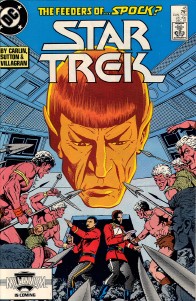
#45 Dec 1987 Devil down below Spock joins with Vaal to restore power to the protective computer system. Kirk admits he was wrong to destroy Vaal and Spock nearly gives up his life to put Gamma Trianguli VI back on course. Stardate 8960.2 Conclusion of a three-part story arc. Writer: Michael Carlin Penciller: Tom Sutton Inker: Ricardo Villagran Cover artists: Brozowski, Lewis
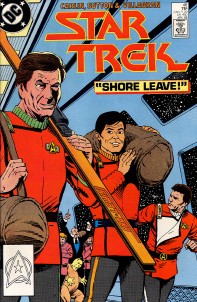
#46 Jan 1988 Getaway On shore leave, Kirk is dogged by a Federation quality control expert assigned to the Enterprise. McCoy breaks a leg sand skiing and romance is the order of the day for other crew members. Stardate 9212.8 Writer: Michael Carlin Penciller: Tom Sutton Inker: Ricardo Villagran Cover artists: Brozowski, Lewis
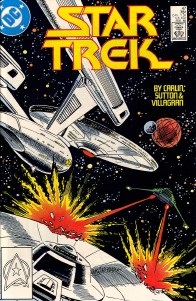
#47 Feb 1988 Idol threats A young officer tries to emulate Kirk after his captain is killed by Romulans and only gets his ship and crew into deeper trouble. Kirk comes to the rescue and learns that his reputation is not exactly what he would like it to be. Stardate 9219.7 Writer: Michael Carlin Penciller: Tom Sutton Inker: Ricardo Villagran Cover artists: Brozowski, Lewis
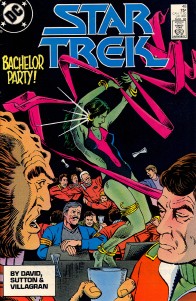
#48 Mar 1988 The stars in secret influence A Federation ship attacks an unarmed Klingon outpost. On the Enterprise, a bachelor party ends in a brawl and Kirk is hit on the head by a bottle. While Kirk decides on punishment, the Enterprise receives word about the outpost. Stardate 8983.2 Issues #48-55 are tied together. This issue is part one of a three-part story arc. Writer: Peter David Penciller: Tom Sutton Inker: Ricardo Villagran Cover artist:
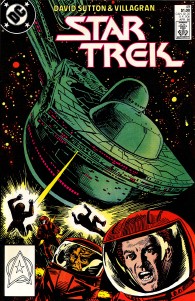
#49 Apr 1988 Aspiring to be angels A group of alien killers is mopping up at the Klingon outpost when the Enterprise arrives. A cloaked ship appears, captures the landing party, and fires on the Enterprise. To prevent Enterprise from firing back, the captured landing party is beamed onto the ship's hull with environment suits. A Klingon ship arrives and captures the landing party. The marauder gets away. Stardate 8987.7 Part two of a three-part story arc. Writer: Peter David Penciller: Tom Sutton Inker: Ricardo Villagran Cover artist:
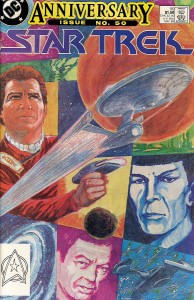
#50 May 1988 Marriage of inconvenience The Enterprise temporarily allies with the Klingons to track down the marauding Federation ship. Arriving at the renegade's next target at high warp, the Enterprise collides with the ship. The crew is captured but the captain gets away. His body is found on a nearby planet, but he has been dead for several weeks. Stardate 8994.6 Confused yet? Conclusion of a three-part story arc. The anniversary logo on the cover of this issue refers to DC Comics' 50th anniversary. Writer: Peter David Penciller: Tom Sutton Inker: Ricardo Villagran Cover artist: Ed Hannigan
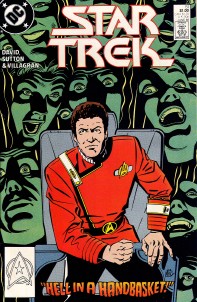
#51 Jun 1988 Haunted honeymoon A telepath falls ill, transforming the Enterprise into a nightmare. The crew experiences hellish illusions and the ship is incapacitated. Kirk, while in conference with Spock, McCoy, and Scotty, sees the Bloom County crew of the good ship Enterpoop. Stardate 9000.0 Part one of a two-part story arc. Writer: Peter David Penciller: Tom Sutton Inker: Ricardo Villagran Cover artist: Mike O'Connell
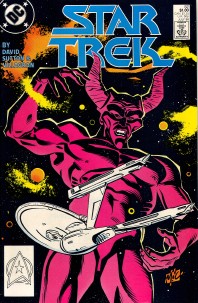
#52 Jul 1988 Hell in a hand basket The Enterprise crew must descend through the circles of hell (as described in Dante's Inferno) until they find the telepath. Spock uses a mind-meld to restore sanity to the ship. Afterward, Bearclaw sinks a knife into Kirk's chest. Stardate 9000.4 Conclusion of a two-part story arc. Writer: Peter David Penciller: Tom Sutton Inker: Ricardo Villagran Cover artist: Mike O'Connell
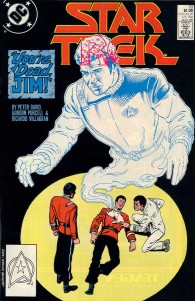
#53 Aug 1988 You're dead, Jim While McCoy works frantically to save Kirk's life, crewmembers remember past occasions with their captain. Kirk receives an invitation to join his brother Sam (introduced during conversation in What Are Little Girls Made Of? and found dead in Operation: Annihilate! ) and son, David. Christopher Pike also warns Kirk that its time to leave. Spock brings Kirk back with a mind-meld. Kirk wants Bearclaw's head on a pike. Stardate 9000.8 Part one of a three-part story arc. Writer: Peter David Penciller: Gordon Purcell Inker: Ricardo Villagran Cover artists: Jerome Moore, KEZ ?
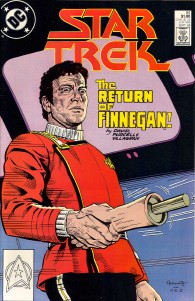
#54 Sep 1988 Old loyalties The Federation Security Legion is called in to investigate the attempt on Kirk's life. The Legion investigator is Sean Finnegan ( Shore Leave ), Kirk's oldest Starfleet Academy nemesis. The investigation into the renegade ship also continues. An Enterprise crewmember is found dead, but she was never reported dead. Stardate 9001.3 Part two of a three-part story arc. Writer: Peter David Penciller: Gordon Purcell Inker: Ricardo Villagran Cover artists: Jerome Moore, KEZ
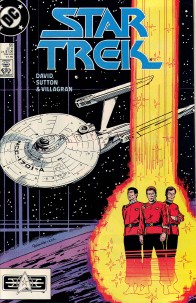
#55 Oct 1988 Finnegan's wake Finnegan unearths the truth about Bearclaw's attempt on Kirk's life, but Garth of Izar ( Whom Gods Destroy ) gets the drop on him and makes one last attempt to kill Kirk. An unexpected turn of events prevents him from finishing the job. Stardate 9002.8 Conclusion of a three-part story arc. Events occuring in this storyline are explored again in TNG novel, Strike Zone . Writer: Peter David Penciller: Tom Sutton Inker: Ricardo Villagran Cover artists: Jerome Moore, KEZ
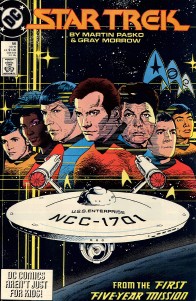
#56 Nov 1988 A small matter of faith Set during Kirk's first five-year mission. While carrying radiation victims to a starbase for emergency treatment, the Enterprise is hijacked by an officer. The ship is taken to a planet where faith healings have been reported. The Enterprise learns of a new type of being. Stardate 3547.2 Writer: Martin Pasko Artist: Gray Morrow Cover artist: Jerome Moore

Screen Rant
The 10 best star trek comics.
From the screen to the page, Star Trek has successfully made the leap to all forms of media. These are the 10 best Star Trek comics of all time.
Though mostly known as a TV and film franchise, Star Trek is also an extremely popular property in the world of books and comics. With a universe of possibilities to explore, it was only natural that the adventures of Star Trek would make their way to the pages of the comic book medium.
RELATED: The 10 Best Star Trek Movies, According To Reddit
Whether it was miniseries from IDW publishing , or lengthy ongoing series from DC comics , Star Trek has been a constant presence in the world of comics for decades. Because there are so many possible stories to tell, Trek will continue to be a go-to comic franchise for years to come.
Star Trek: Deep Space Nine — Too Long A Sacrifice (2020)
Ever since publisher IDW took over the Star Trek license, they have used it as an opportunity to tell a plethora of interesting one-off stories. Too Long a Sacrifice is set during the darkest days of Deep Space Nine 's Dominion War, and focuses on Odo as he investigates a series of terrorist attacks on the station.
Odo was always one of DS9 's best characters each season , and the book allows him to shine in comic form as well. Told more like a noir story than an episode of Trek , the book is both dark and fascinating. Helped along by its uniquely cinematic art style, the story is rich and complicated, and there is never a dull moment during the four issue run.
Star Trek (1967-1979)
When the show was canceled at the end of the 1960s, fans of Star Trek were left with little of their favorite franchise to enjoy. To fill that void, publisher Gold Key Comics produced a monthly Trek series that presented the further adventures of The Original Series .
Though canonically ignored today, the Gold Key stories are recognizably Star Trek , and feel like lost episodes of the show. Not afraid to take the stories in strange, distinctly comic book directions, the series was a unique interpretation of the series and even introduced new characters.
Star Trek: The Last Generation (2008-2009)
The Myriad Universe that was developed for the Star Trek novels was perfect fodder for the comics and IDW jumped on the idea quickly. The Last Generation is a alternate timeline miniseries that explores what would have happened if James Kirk had failed to stop the assassination attempt during the events of Star Trek VI: The Undiscovered Country .
Set during the same time as the early seasons of The Next Generation , the story sees a version of earth that has been conquered by the Klingon Empire. Though the story is darker and less optimistic than the typical Trek fare, it is still a fascinating glimpse into what could have been.
Star Trek/Planet Of The Apes: Primate Directive (2014-2015)
The world of comics allows writers to explore strange and unusual crossovers that would otherwise not be possible in film and TV. Primate Directive sees the crew of the Enterprise enter another universe where the events of The Planet of the Apes films take place. Following a ship full of Klingons onto the planet, the Enterprise bunch must find a way to deal with the Klingons without violating the prime directive.
RELATED: Every Planet Of The Apes Movie (Ranked By Metacritic)
Despite its wacky premise, the story is tightly written and is quite faithful to the lore of both franchises. The simplicity of the setup allows the strange storyline to feel like an extended episode of the TV series and it never goes too far with its concept.
Star Trek: The Q Conflict (2019)
Each of the Star Trek television series have their own unique flavor, and a story that combined them all was an interesting proposition. The Q Conflict sees captains Kirk, Picard, Sisko, and Janeway together in a rigged competition that was arranged by the omnipotent being known as Q.
Seeing the characters combine their specific strengths together was a dream come true for Trek fans, and seeing it in service of a Q story was even better. The book, though complex, stays true to its source material and writes its characters accurately to the way they were portrayed in their respective shows.
Star Trek: Crew (2009)
Though there is a wealth of Star Trek media, there are still many characters who's backstories haven't been fleshed out. Star Trek: Crew follows the early career of the character Number One who served as first officer on the Enterprise under Captain Pike.
Only seen in the episode "The Cage", Number One saw a much larger role in the expanded universe and appeared in comics and books frequently. Crew explores her career and the steps she took to get herself into the vaunted position that she eventually earned. Told like an anthology, each issue of the miniseries focuses on a different part of her career.
Star Trek: The Next Generation — Mirror Broken (2017)
Though the mirror universe episodes are often the best episodes of Star Trek , TNG never took the time to explore it during its seven seasons. Mirror Broken catches the reader up to speed on the mirror universe and shows what each of the members of the TNG crew is doing in the alternate universe.
One of the strengths of the miniseries is its ability to impart a lot of information in a digestible and fun-to-read manner. The mirror universe is just as complicated as the normal timeline, and it was therefore necessary to catch the reader up quickly. Though the story isn't as fleshed out as other miniseries, it is still a fascinating glimpse into the mirror universe.
Star Trek: Year Four (2007-2008)
After its untimely cancelation after three seasons, many fans of Star Trek were left to speculate as to what happened in the other years of the crew's five year mission. Year Four attempts to fill in those gaps by presenting stories set during the fourth year of the journey.
RELATED: The 10 Best Star Wars Comic Book Arcs
Essentially acting as a fourth season of TOS , Year Four reads like many of the best episodes of The Original Series and is very much in the same spirit as the show. The anthology style of the stories makes them infinitely re-readable, and there is something for every type of Trek aficionado.
Star Trek (1984-1996)
When DC comics took over the Star Trek license in the 1980s, they didn't hesitate to capitalize on a world of opportunities. Set over two volumes, Star Trek is perhaps the most comprehensive ongoing Trek comic of all time. Telling stories set during the TOS era as well as between the films, each issue further explored the universe of Trek .
The scope of the series is impressive and it is still the longest running Trek comic of all time. On top of that, it also presented old characters in new stories, as well as fleshed out the backstories of the Enterprise's main crew.
Star Trek: Mission's End (2009)
While many stories were told during the Enterprise's five year mission, none had attempted to establish what happened on her last voyage. Mission's End sees the Enterprise brokering negotiations that would allow the planet Archernar IV to join the Federation.
The beauty of the story is how it cleverly establishes where Kirk, Spock, and McCoy end up and why they are where they are at the beginning of Star Trek The Motion Picture . Though books like Year Five told stories within the last year of their journey, only Mission's End attempted to wrap things up neatly.
NEXT: The 20 Best Star Trek: The Next Generation Episodes Of All Time
Celebrating the best of tv, movies, and comics
Star Trek: The 10 best Star Trek comics from Marvel, DC, IDW Publishing, and more
These are the voyages of the Star Trek cast and crew across multiple comic publishers and universes in the world of comics
Welcome to the world of Star Trek comics!
In 1966, Gene Roddenberry launched what he called 'Wagon Train to the Stars.' Although he sold the studio on the idea that Star Trek would be a Western in space, Roddenberry was more inspired by Gulliver's Travels. So he created an adventure series with something to say about political, philosophical, and social issues and shaped history. Not only did Star Trek champion and codify 'infinite diversity in infinite combinations,' it made science appealing. It even inspired numerous scientists to enter STEM and influenced fandoms far beyond its own. Slash fiction fans can thank Mr. Spock (Leonard Nimoy) and Captain James T. Kirk (William Shatner) from Star Trek: The Original Series (TOS) for legitimizing the idea of shipping with Diane Marchant's 1974 Kirk/Spock story 'A Fragment Out of Time.'
The original Stat Trek was canceled after three seasons. However, with the help of a loyal fan base (known as Trekkies or Trekkers) and a successful run in syndication, the franchise didn't die when the series first ended. Nearly two decades afterStar Trek: The Original Series entered syndication, Star Trek was the number one syndicated show on television in 1986 according to Nielsen. Just one year later, Star Trek: The Next Generation (TNG) debuted and lead a franchise revival that inspired more Trekkies for generations to come. However, with the series off the air for a long time between Star Trek: The Original Series's end and Star Trek: The Next Generation's beginning, Trekkies were hungry for more content starring the Enterprise crew, and beta canon and fanon (fan + canon = fanon) were born.
In Star Trek, events taking place within the live-action episodes and movies are official canon or alpha canon, while other official content is mostly up for debate. The beta canon includes most of the official Star Trek novels, video games, and comic lines. But as the Star Trek TV revival continues to take Trekkies to strange new worlds, production writers have started to include details from beta canon stories. Star Trek: Prodigy introduced Rok-Tahk, a Brikarian (first appeared in the Star Trek: The Next Generation - Starfleet Academy novel, Worf's First Adventure), and chimerium (the legally controlled material used in Klingon cloaking devices first appeared in Starfleet Corps of Engineers and The Next Generation books), and both beta canon and fanon influenced the Kobayashi Maru sequence.
Beta canon is the key to boldly exploring exciting new Star Trek stories. Whether you're eager for more information about your favorite character or on the hunt for new adventures, some of the franchise's best stories are given life in the panels of a comic book. But it's easy to feel overwhelmed. Since Gold Key Comics published the first Star Trek comic book in 1967, although it couldn't use storylines from the series, thousands more Star Trek comics over multiple series have been published. Since it can be hard to know where to begin, we list the ten best storylines to get you started below.
Star Trek: The Next Generation – Mirror Broken

Space... The Final Frontier. These are the voyages of the ISS Enterprise-D and its captain, Mirror Picard. Its continuing mission: to conquer strange new worlds, to enslave new life and new civilizations all for the Terran Empire! IDW Publishing's Star Trek: The Next Generation: Mirror Broken by Scott and David Tipton, J.K. Woodward, Charlie Kirchoff, and Carlos Nieto takes you into the other dimension where all of your favorite TNG heroes have grown up to value what the publisher describes as their "worst instincts and potentials" (just wait until you see Wesley Crusher's hair).
In the Mirror Universe, officers are valued for their brutality, cruelty, and cunning, not their kindness. However, that's what makes the Mirror Universe so appealing, the chance to see our Star Trek's greatest heroes wrestle with facing off against the worst versions of themselves, which forces them to confront their own demons.
Since the The Next Generation crew never went to the perennial fan-favorite Mirror Universe onscreen, the Mirror Picard versus Picard showdown in the comics is exciting to see. And that's only just the beginning; the Mirror Saga continued with Star Trek: The Mirror War.
Star Trek: The Original Series – Debt of Honor
Debt of Honor by Chris Claremont, Adam Hughes, Karl Story, Tom McCraw, and Robert M. Pinaha was initially published in 1992 when DC still had the Star Trek license. Nearly 30 years later, it was re-released at IDW, introducing it to a whole new generation of Trekkies.
The Star Trek OGN picks up after the Star Trek IV: The Voyage Home with Kirk and Gillian, the whale biologist from the film. Now living in the 23rd century, Gillian is adapting to life in the future. However, leaving her century is more challenging than expected (even the textiles don't feel right on her skin), but luckily Kirk is there to help her through. But Kirk and Gillian's vacation to check on the whales they brought to the future is only a ruse, and Kirk quickly finds himself aboard the Enterprise on a mission alongside the Klingons and Romulans.
Debt of Honor sends Kirk on a mission that leaves him thinking about his past. Interwoven throughout the story are flashbacks to the ups and downs of Kirk's career, providing excellent insight into the franchise's first captain, who is haunted by the destruction of the Enterprise and death of his son in Star Trek III: The Search for Spock.
Star Trek: Discovery – Adventures in the 32nd Century
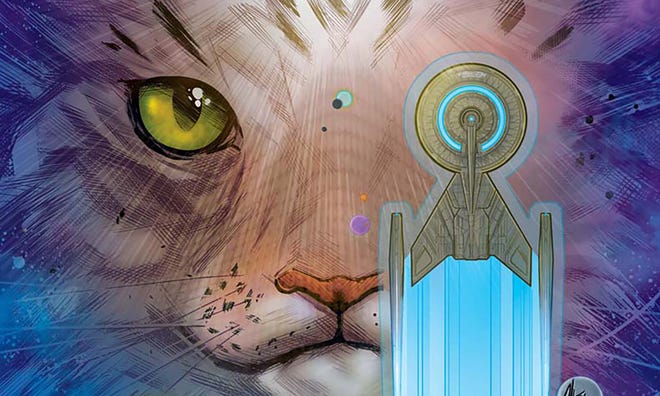
IDW's Star Trek: Discovery – Adventures in the 32nd Century by Mike Johnson, Angel Hernandez, J.D. Mettler, and Neil Uyetake is a four-issue Discovery (DISCO) miniseries featuring Grudge the Cat, Lieutenant Keyla Detmer, Science Officer Linus, and Adira Tal. Each character gets a spotlight issue, giving us a deeper understanding of the psychology and backgrounds of DISCO's less featured characters.
The series contains many highlights like the first issue, which is a flashback tale told from Queen Grudge's perspective. It delves into the monarch's relationship with Cleveland Booker. We learn how Booker found his Queen and what she loves about him in return. And yesh, it's the tasty treats! Booker always gives his Queen the 32nd Century version of Fancy Feast. Afte all, she is too good for replicator food, not like that pathetic Spot.
But this miniseries gets a special shout-out for its second issue about Adira Tal and Gray's history together. Trans fans are desperate for more representation on screen and in comics, and the storyline gets the couple's dynamic perfectly. How do you like them apples?
Star Trek: Voyager – Seven's Reckoning
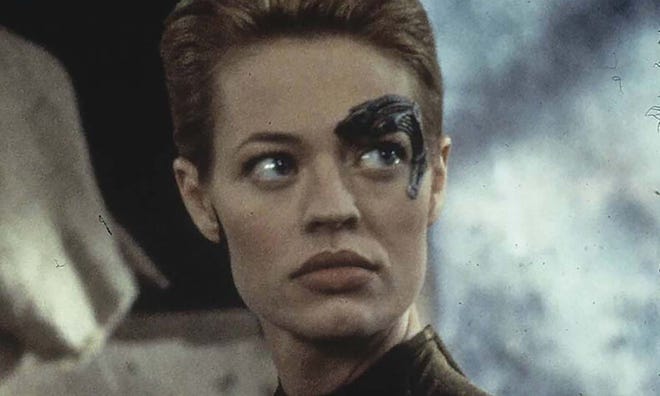
Seven's Reckoning by Dave Baker, Angel Hernandez, Ronda Pattison, and Neil Uyetake is a four-issue series during Voyager's fourth season. The series explores Seven's struggle to find her individuality and humanity, leading to hysterical exchanges about humanity's propensity for distracting outbursts between the ex-Borg and Tuvok. Most importantly, Seven learns about how stories reflect a society's cultures and values, which can either encourage our individuality or enslave us.
As an ex-Borg, Seven of Nine provided the Voyager writers with endless opportunities to use her as humanity's foil. The comics are no different, and Seven's Reckoning delivers on this theme. Plus, I'm as subtle about how much I like Baker's writing as Beckett Mariner is about her crush on Jen the Andorian. But seriously, the Eisner-nominated creator's work (not to mention all the other talent) on this Voyager run is worth the price of a collection alone.
Star Trek: The Original Series – Star Trek #24 and #25
DC Comics held the license to publish Star Trek stories from 1984 to 1996. DC's main title was Star Trek, published in two series (the first one is set after Star Trek II: The Wrath of Khan and the second after Star Trek V: The Final Frontier), comprising 136 issues, nine annuals, and several special issues. DC's Star Trek harnesses the full force of Trek mythology (and was the first publisher to do so), with characters from all over the universe making appearances.
The Star Trek run not only included stories featuring characters from The Original Series, Star Trek: The Animated Series (like the Edosian Arex and Caitian M'Ress), and the franchise films, but it also introduced new ones like Ensign William Bearclaw, Ensign Nancy Bryce, Dr. Chu-Sa, Lt. Commander Maria Morelli, Ensign Elizabeth Sherwood, and the Klingons Konom and Bernie.
Sometimes the stories in DC Comics era are straight-up sequels to storylines started in the films or TV shows. But the series shines when it introduces new ideas to the Star Trek canon.
In Star Trek #24 and #25, 'Double Blind,' by Diane Duane, Tom Sutton, Michele Wolfman, Agustin Mas, and Ricardo Villagran, the Enterprise crew is tricked into helping a lobster-like species and a domestic cat-like species (no, not the Caitians or Kizinti). Ultimately, Kirk comes up with a typical solution for him that requires ignoring the Prime Directive to end the long feud between the two species based on mutual misunderstanding and fear. Who doesn't love Captain Kirk being a Captain Kirk?

Star Trek: Starfleet Academy
Following approximately six months behind the Star Trek: Deep Space Nine's (DS9) continuity, Marvel Presents Paramount Comics' Star Trek: Starfleet Academy series follows the Omega Squad. It features Deep Space Nine's Nog and his Academy classmates, a new group of cadets that we meet in Prime Directive, Starfleet Academy's first issue, by Chris Cooper, Chris Renaud, Andy Lanning, Jim Novak, and Kevin Somers. The comic book series also has cameo appearances from characters on the TV shows like Groundskeeper Boothby from the The Next Generation episode 'The First Duty' and Red Squad from the Deep Space Nine episodes such as 'Valiant.'
Strange New Worlds' Captain Christopher Pike even appears in Starfleet Academy when Nog and Omega Squad wind up on Talos IV to save the Talosians from the Jem'Hadar in Star Trek: Starfleet Academy #9. The story builds on 'The Cage' and 'The Menagerie Part I and Part II,' 100 years in the past on the Star Trek timeline. Pike explains to the cadets that Starfleet has since declared Talos IV off-limits because of the dangers of Talosian mind control (which unfortunately don't work so well on angry Jem'Hadar).
Star Trek: Early Voyages and Starfleet Academy were the two most popular series published by Marvel during its stint publishing Star Trek comics. However, it is great to see more of Nog as a cadet. And today, Starfleet Academy is more relevant than ever with Paramount+'s announcement that they are developing a Starfleet Academy TV series.
Star Trek: Voyager
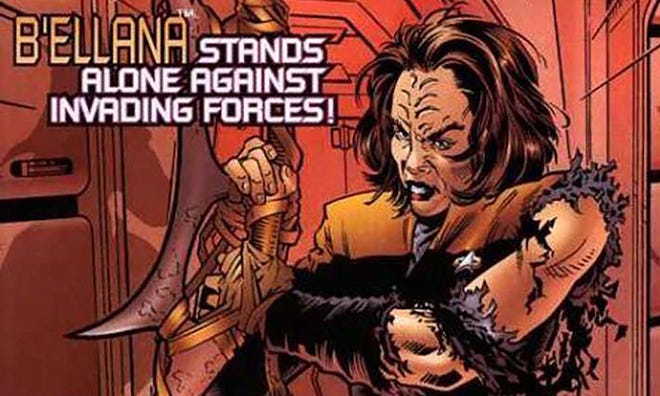
The USS Voyager crew appeared for the first time ever in their own comic book series in 1996, published by Marvel Presents Paramounts Comics. The 15-issue series by Laurie Sutton, Jesus Redondo, Matt Webb, John Kalisz, and Chris Eliopoulos (and periodically some guest creators) covers a lot of narrative ground, following the USS Voyager crew from Voyage season two through season four.
As the first series in a long line of great Voyager content in beta canon, the Paramount run starring Captain Janeway and her crew deserves a special spot in your short box. After all, she is the first female captain to star in her own series!
Star Trek: Deep Space Nine
Paramount Comics picked up Star Trek: Deep Space Nine in 1996, and the series ran until 1998. Although the Deep Space Nine series takes place during the show's fourth and fifth seasons—connecting it to Nog and the Star Trek: Starfleet Academy series — it continues stories from earlier seasons, as well. The best Star Trek comics allow creators to return to their favorite stories from the TV shows. And Deep SPace Nine does just that, with Lwaxana Troi, who already has a penchant for showing up when you least expect it.
On DS9, Lwaxana Troi made several memorable guest appearances in the series, with her first being 'The Forsaken,' in which the daughter of the Fifth House of Betazed, the holder of the Sacred Chalice of Rixx, and heir to the Holy Rings of Betazed gets a huge middle-school-sized crush on Odo. Unfortunately for the Constable (who does not understand the concepts the solids call 'love' yet), he is trapped in an elevator episode and a fantastic storyline ensues. The Lwaxana and Odo story is picked up again in the season three episode 'Fascination.' And then again, in Paramount Comics.
When the Holy Rings of Betazed of Surprise shows up in issue ten by Andy Mangels, Michael Martin, Terry Pallot, Al Milgrom, John Kalisz, and Chris Eliopoulos, she upends the whole promenade for her 'Wedding of Doom.' Not only does this series do a good job of bringing you into the wacky wartime world of Deeep Space Nine, it also delivers small lines that the most ardent Trekkie will love. Garak and the Doctor have a similar exchange to the one in Star Trek VI: Undiscovered Country, with Garak asking the Doctor if he's read Shakespeare in the Cardassian.
Star Trek: The Next Generation/X-Men
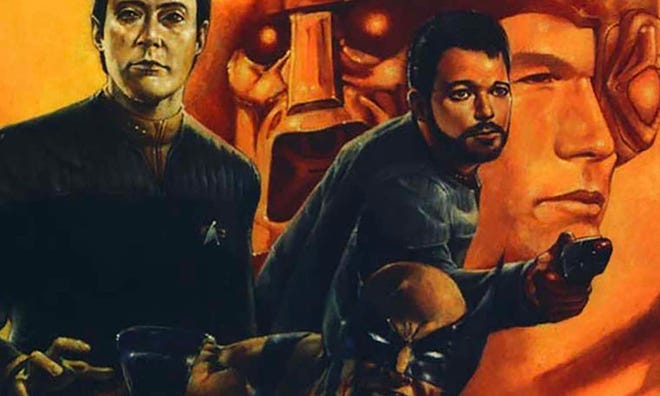
Star Trek: The Next Generation/X-Men: Planet X by Michael Jan Friedman is the answer to franchise fatigue, am I right? Whether you're a Trekkie or a True Believer, thinking about Sir Patrick Stewart's Captain Picard meeting Sir Partick Stewart's Professor Charles Xavier just seems like a good time. So, of course, the eponymous crossover novel starring the X-Men and TNG bridge crew made the New York Times bestseller's list when it came out, leading to a follow-up Marvel Comics one-shot.
Yes, Planet X goes there (re: the two men's likeness), which is pretty impressive considering Friedman wrote the book in 1998. Picard even comments on the similarities between him and Professor X during a holodeck simulation, "As the doctor had warned him, he and the professor bore a passing resemblance."
With the success of Planet X, the two men finally had a chance to meet in the panels of a comic book. While Planet X took place in the Star Trek Universe, Star Trek: The Next Generation/X-Men: Second Contact by Dan Abnett, Ian Edington, Cary Nord, Scott Koblish, Liquid! and Chris Eliopoulos takes place on Earth in the '90s, where the crew of the Enterprise-E must locate Xavier's School for Gifted Youngsters. Always the ladies' man, Jean-Luc hits it off with Storm.
Star Trek: Strange New Worlds
No, this isn't an adaptation of the Paramount+ series. This happened years before, in comic books.
"Gary Mitchell was an ant, and I am a lion!" Created by John Byrne in 2013, the comic book Strange New Worlds uses imagery from The Original Series to tell the untold sequel to the second pilot, 'Where No Man Has Gone Before.' Yes, that means this Star Trek photonovel is all about the USS. Enterprise crew returning to Delta Vega, and Captain Kirk must confront his past demons Gary Mitchell.
The Strange New Worlds photonovel is essential reading if you love the Star Trek: Lower Decks episode 'Second Contact.' It's not the only comic to return to Delta Vega. But it's the only Gary Mitchell comic to use Gary Lockwood's likeness to explore the character's God-like abilities. Initially planned as a one-shot, SNW did well enough to lead to Byrne's ongoing photonovel series Star Trek: New Visions. The photonovels are perfect if you are craving new stories with the The Original Series bridge crew, mainly because Byrne uses images from the series to tell the stories.
Watch the Star Trek: Strange New Worlds season 2 panel with Rebecca Romijn, Ethan Peck, Celia Rose Gooding, and Melissa Navia .
MCM Comic Con
Florida Supercon
Comic-Con International: San Diego
New York Comic Con
- Sequart News
- Waxing and Waning: Essays on Moon Knight
- Judging Dredd: Examining the World of Judge Dredd
- From Bayou to Abyss: Examining John Constantine, Hellblazer
- Moving Target: The History and Evolution of Green Arrow
- The Devil is in the Details: Examining Matt Murdock and Daredevil
- Teenagers from the Future: Essays on the Legion of Super-Heroes
- The Citybot's Library: Essays on the Transformers
- Unauthorized Offworld Activation: Exploring the Stargate Franchise
- Somewhere Beyond the Heavens: Exploring Battlestar Galactica
- The Cyberpunk Nexus: Exploring the Blade Runner Universe
- A More Civilized Age: Exploring the Star Wars Expanded Universe
- Bright Eyes, Ape City: Examining the Planet of the Apes Mythos
- A Galaxy Far, Far Away: Exploring Star Wars Comics
- A Long Time Ago: Exploring the Star Wars Cinematic Universe
- The Sacred Scrolls: Comics on the Planet of the Apes
- New Life and New Civilizations: Exploring Star Trek Comics
- The Weirdest Sci-Fi Comic Ever Made: Understanding Jack Kirby's 2001: A Space Odyssey
- The Anatomy of Zur-en-Arrh: Understanding Grant Morrison's Batman
- Curing the Postmodern Blues: Reading Grant Morrison and Chris Weston's The Filth in the 21st Century
- Our Sentence is Up: Seeing Grant Morrison's The Invisibles
- Grant Morrison: The Early Years
- Warren Ellis: The Captured Ghosts Interviews
- Voyage in Noise: Warren Ellis and the Demise of Western Civilization
- Shot in the Face: A Savage Journey to the Heart of Transmetropolitan
- Keeping the World Strange: A Planetary Guide
- Why Do We Fall?: Examining Christopher Nolan's The Dark Knight Trilogy
- Musings on Monsters: Observations on the World of Classic Horror
- Time is a Flat Circle: Examining True Detective , Season One
- Moving Panels: Translating Comics to Film
- Gotham City 14 Miles: 14 Essays on Why the 1960s Batman TV Series Matters
- Mutant Cinema: The X-Men Trilogy from Comics to Screen
- Improving the Foundations: Batman Begins from Comics to Screen
- How to Analyze & Review Comics: A Handbook on Comics Criticism
- The Mignolaverse: Hellboy and the Comics Art of Mike Mignola
- Humans and Paragons: Essays on Super-Hero Justice
- The Best There is at What He Does: Examining Chris Claremont’s X-Men
- The British Invasion: Alan Moore, Neil Gaiman, Grant Morrison, and the Invention of the Modern Comic Book Writer
- Classics on Infinite Earths: The Justice League and DC Crossover Canon
- The Future of Comics, the Future of Men: Matt Fraction's Casanova
- When Manga Came to America: Super-Hero Revisionism in Mai, the Psychic Girl
- Minutes to Midnight: Twelve Essays on Watchmen
- The End of Seduction: The Tragedy of Fredric Wertham
- Because We are Compelled: How Watchmen Interrogates the Comics Tradition
- Blind Dates and Broken Hearts: The Tragic Loves of Matthew Murdock
- Everything and a Mini-Series for the Kitchen Sink: Understanding Infinite Crisis
- Revisionism, Radical Experimentation, and Dystopia in Keith Giffen's Legion of Super-Heroes
- And the Universe so Big: Understanding Batman: The Killing Joke
- This Lightning, This Madness: Understanding Alan Moore's Miracleman, Book One
- Stories out of Time and Space, Vol. 1
- Knight's Past: A Starman Companion
- Neil Gaiman: Dream Dangerously
- She Makes Comics
- Diagram for Delinquents
- The Image Revolution
- Comics in Focus: Chris Claremont's X-Men
- Warren Ellis: Captured Ghosts
- Grant Morrison: Talking with Gods
- THE CONTINUITY PAGES
- Create Free Account
- Search for:
On the Very First Star Trek #1
Star Trek has a long history in comics. In fact, the very first Star Trek comic book began in 1967, at the end of the original series’s very first season.
This first series was published by Gold Key, an imprint of Western Publishing founded only five years before, in 1962. Gold Key experimented with the comics format, initially using rectangular word balloons and thought bubbles, to give their comics a sleeker feeling for a new era. Although Gold Key abandoned this, it produced big black-and-white hardcover reprints and slimmer original hardcovers, aiming at the book and department store market in a manner that prefigured the rise of the graphic novel.
Perhaps aiming at this wider audience, the publisher was known for its remarkably array of licensed properties. It’s hard to imagine a better staple of child-oriented fare than characters licensed from Disney ( Uncle Scrooge ), Warner Bros. ( Bugs Bunny and Daffy Duck ), Hannah-Barbera ( The Flintstones ), and Universal ( Woody Woodpecker ). But Gold Key also published characters licensed from King Features Syndicate (like Flash Gordon and The Phantom ) and plenty of titles drawn from TV, including The Three Stooges , My Favorite Martian , Ripley’s Believe It or Not , and even The Twilight Zone .
Yes, and also Star Trek .
Gold Key not only began Star Trek in 1967, when the TV show hadn’t even been on the air for a year. But Gold Key kept publishing Star Trek comics after the TV show was canceled in 1969. The comics series continued through the 1973-1974 Star Trek animated series, outlasting it too. Gold Key’s series finally came to an end in 1979 (#61, Mar 1979) — almost a decade after the original series had aired its final episode. The comic wasn’t cancelled due to low sales, but rather because Gold Key lost the Star Trek license to Marvel, on the eve of the first Star Trek movie ( Star Trek: The Motion Picture , which debuted on 7 Dec 1979).
In comparison, the first original Trek novel (Mack Reynolds’s Mission to Horatius , which featured illustrations by Sparky Moore) was published in 1968. It was the only such novel published while the original series was airing. The next (James Blish’s Spock Must Die! ) didn’t appear until 1970. The next appeared in 1976, after the animated series was also off the air. Trek novels have been appearing regularly ever since, often enough to great attention and occasional acclaim.
But Trek comics? They were a part of Star Trek almost from the start.
Most Gold Key covers were painted, helping to make its comics visually distinctive next to the line art of other publishers’ covers. Instead, the first nine issues of Star Trek featured stylish photo-collage covers that were no less distinctive. Particularly successful was the multiple, differently colored Enterprises on the cover of issue #4 (June 1969), with text describing the story inside running across the cover along the same rising line as the ships. So too was the cover for issue #7 (Mar 1970), with a purple Spock gazing upward, while Kirk and Bones stare out from colored trapezoidal panels, joined between them by an orange line like some sort of mod, 1960s light fixture. Beginning with issue #10 (May 1971), Gold Key’s typical painted covers began, although with tiny photos of Kirk and Spock as a visual reminder of the original series (at least until #45, July 1977, when those too disappeared).
In fact, almost everything about the series’s presentation was stylish. The comic didn’t use the original series’s on-screen logo — which wasn’t nearly so iconic then. Instead, the comic had its own version of the Star Trek logo — a jazzy, wild thing that seemed to pivot along a central line, defined by a tiny, silhouetted Enterprise’s route.
Rounding out the comic, in the early issues, was photographic material from the show. In the first issue, for example, the inside front cover presents an image of the Enterprise herself and brief text adapting (sacrilege!) the voice-over heard during the opening titles. It’s a particularly stylish way of recapping the series’s premise (fulfilling the same function Marvel later did with awkward boxes at the top of its comics’ first pages). The inside back cover presented a couple photos along with text about Kirk’s greatness and the crew’s loyalty to him, in the style of a movie photo book. (The text incorrectly states that the ship’s crew numbers into the “thousands.”) The back cover is a rather suggestive image of Kirk, framed on the top and bottom by stylish, angled color swaths.
The Gold Key Star Trek stories had a unique format. Running 22-26 pages (a number that diminished over time), each story was broken into two parts (roughly of equal length). This break doesn’t add much, although occasionally it can feel like a representation of a commercial break, as if one is reading two acts out of a half-hour show (which is usually broken into three or even four acts, each separated by a commercial).
Each story also began with a splash page, teasing what would happen later in the tale, before jumping backwards to show how this situation developed. Silver Age DC comics often used this same device, frequently using the opening splash page as a kind of second cover, teasing the drama that was to come. Technically, Gold Key Star Trek comics would abandon the splash page, since it broke that first page up into multiple panels — but these first pages, despite having multiple panels, continued to jump forward in time and tease the story to come until Gold Key’s final issue.
While this device is rooted in comic books, it has a special resonance with Star Trek , which sometimes featured teasers — the brief segment before the title sequence — that were quite shocking and seemed to radically upset the status quo. One example is “The Enterprise Incident” (which aired as episode two of season three), which opens with Kirk, appearing somewhat emotionally disturbed, ordering the ship into the Neutral Zone against Federation law, where the ship’s quickly surrounded by Romulan ships. True, such episodes don’t then flashback to reveal how they got into these extraordinary situations — instead, these details are provided through revelations as the story unfolds, without flashback. Nonetheless, the opening flash-forward page of Gold Key’s Trek comics can, at best, produce some of the same sense of dislocation for the audience that some classic Trek episodes did.
Early Trek stories, outside of the original series, are often fascinating for how different they are from the show — which wasn’t yet considered a beloved touchstone of American culture and certainly wasn’t available on demand for all to see at their convenience. Even the animated series — which was endorsed by Trek creator Gene Roddenberry, starred almost the entire original cast as voice actors, and even featured some of the original series writers (such as D. C. Fontana) — took liberties, adding force field belts to avoid animating space suits, casually inserted a holodeck onto Kirk’s Enterprise, and featured an episode (“The Slaver Weapon,” by Larry Niven) that massively rewrote the galaxy’s entire history in ways that would (thankfully) never be mentioned again.
But then again, the original series didn’t see itself as sacred either. Roddenberry refused to pin down when the series was set, preferring to keep it ambiguous, and several inconsistent references resulted. There’s a lot of silliness too — and not just the god-like beings that pop up every few episodes, nor people after Spock’s brain. Indeed, one of the things that separates the original series from its later spin-offs — besides that almost every episode, with a musical signal, goes into hand-to-hand combat mode at some point — is the original series’s humor . Part of the show’s charm was that, for all its intelligence and philosophizing, it never took itself too seriously.
So it shouldn’t be surprising that the first Trek comic series differed from the original series we remember (or think we do).
For one thing, the series’s first artist was the Italian artist Alberto Giolitti, who had never viewed the show and used publicity photos as reference. He didn’t have a photo for Scotty (played by James Doohan), so he essentially recast the role!
When artists had to invent a design for a car or a ship from scratch, knowing Star Trek was set in the future, they frequently designed sleek and futuristic vehicles — that often seemed powered by rockets. Such designs seemed to belong more to Gold Key’s Flash Gordon . Vehicle design on Star Trek , while often brilliant, also tended toward the boxy — because physical models of ships had to be glued together, often on the cheap, and filmed. Seeing a sleek hover-car that could be made of glass blows the whole aesthetic.
Harry Mudd's ship, from the Gold Key series's final issue.
The Very First Star Trek Comic Ever: A Dead Galaxy, Tentacle Rape, Vore, and Genocide
More importantly, the series often had a somewhat different tone than the original series, and that’s visible even in the first issue. Titled “The Planet of No Return” (although the cover promises “K-G, Planet of Death!”), the tale opens with a splash page, showing crew members battling “a — a giant cannibal plant! ” before jumping backwards.
Typical of Gold Key stories, the first page is followed by a Captain’s Log, beginning the actual story. This first one’s a little different. In fact, it doesn’t seem to understand the premise of Star Trek . Kirk narrates that the ship is “carrying out exploration of Galaxy Alpha. So far we’ve seen no exploration of life anywhere in the galaxy…” Of course, the TV show was set in our galaxy (which obviously has plenty of life in it, so it can’t be Galaxy Alpha). Outside of occasional stories featuring highly-advanced civilizations, no one’s bouncing from galaxy to galaxy in the Star Trek universe — much less so casually exploring an entire one, seemingly alone, as this caption suggests. (Of course, plenty of comics writers have confused the galaxy for the universe, so the error’s hardly unique; in fact, it’s indicative of a wider astronomical sloppiness, especially in comics.)
After finding a planet (in this otherwise lifeless galaxy) that’s teeming with plant life, the Enterprise… descends into the planet’s atmosphere. This isn’t something ever seen on the show, and it’s not clear why the ship does this. It’s certainly not to land or even to dispatch a shuttlecraft, because the landing party soon teleports down, as usual.
The descent into the planet’s atmosphere is convenient, from a plot standpoint, because it allows spores to attach to the ship, burrow through it, infect animals held in cages, and turn them into giant carnivorous plants, complete with grasping tentacles. Security soon dispatches the threat, however, making the whole business unnecessary — if it’s drama the story needs, it could arrive at it just as quickly after the crew teleports down to the surface (in a transporter that looks rather different than the one seen on the show). Unsurprisingly, there’s no mention of the fact that, had spores burrowed through the ship, it would obviously no longer be space-worthy.
Once on the planet, the landing party almost immediately witness — surprise! — the plant spores transforming a crew member. This ought not to come as a surprise , since they’ve just witnessed this same thing happen to what look like caged rats. You’d think Spock or Bones would’ve run a test, since they’re landing on the planet from which these spores originated, to see if they could affect humans . Or someone might have said, “Hey! You know what? How ’bout we teleport down in space suits just to be sure!” Instead, no precautions seem to have been taken whatsoever.
Good thing, too, because the transformed crewman, now a giant tree, soon saves everyone else by battling a giant plant beast. Instead of teleporting back up to the Enterprise, the crew goes exploring — on a planet where anyone can be transformed into a giant tree at any time. Soon, the crew finds a plant civilization .
Now, this is cool stuff, and Alan Moore might have done great things with such a concept, were he to have featured this planet in Swamp Thing . But Alan Moore this ain’t. So instead, the crew’s accosted by the plant city’s sentries. The crew flees, but Janice (Rand, a blonde with whom Kirk had a mutual attraction on the show) can’t keep up the pace, letting Kirk casually call her “honey.” Ah, the Sixties.
And then Janice Rand is… captured by a giant plant’s… tentacles.
That's not suggestive at ALL.
That’s right: decades before “tentacle rape” entered the common American vocabulary, it was teased in the very first Star Trek comic ever made. As the rest of the crew makes their escape, someone even asks, “What’s that loathsome thing doing with Janice?” In the next panel, as the plant’s tentacle pulls her in, she’s shown in silhouette, legs in the air, the tentacle running underneath them.
It’s like a Rorschach blot. It’s only dirty if you think it is.
Well, kind of. Because then we’re shown a crewman climbing a tree to get a look at what this thing is doing to Janice. The art isn’t clear, but the crewman tells us what he sees: “Oh, no… no! I-it’s terrible. J-Janice… she’s being put into a… a… cattle pen! ”
Now, it’s kind of a cool twist that a living plant would treat humans the way we treat animals. Except we haven’t seen any animals on this planet yet — presumably, they’d be transformed into plants by those spores pretty quickly. So why does this tentacled, girl-capturing plant monster have a cattle pen handy?
Just to make this depiction worse, this is the cliffhanger ending of part one — Janice Rand at the mercy of a tentacle monster that’s putting her in a cattle pen.
This isn’t exactly the kind of cerebral, culturally challenging stuff that Star Trek came to be known for. Of course, it hadn’t yet. It was to many primarily an outer-space fantasy show, with lots of fistfights and weird planets — and yes, some damsels in distress too. Living plants were simply an idea too expensive for TV to film. There’s no denying the comic lacks the show’s overall intelligence, but one can see how, in 1967, this didn’t necessarily seem that out of sync with the show.
As part two begins, we see this cattle pen does have strange local animals in it. What’s more, there are sentient tumbleweed-like plants that herd the animals to an eating area. The animals are given vegetables to eat, and the Enterprise crew guesses that these vegetables are sentient too — but lower in the plants’ social hierarchy, and thus grown as food for the animal population, which is in turn devoured alive by larger, tree-like plants — which we soon witness.
It’s all incredibly trippy stuff, even if it doesn’t entirely make sense.
But of course, the focus of this is on the captive Janice Rand, who’s now going to be eaten alive by giant trees . So now you can add vore to the tentacle rape overtones.
As Janice tries to fight off the giant tree’s literally hungry advances, the male crewmen concoct a rescue plan: to have Spock, still on the Enterprise, blast the menacing plants from orbit. Naturally, this requires a great deal of precision, and there’s risk of hitting — and killing — Janice. It’s also a maneuver very rarely seen on the show, because it would be too powerful, if perfected, to allow many plots to continue their drama. Naturally, Spock succeeds, causing a great explosion on the surface, and Janice is rescued.
And then, Kirk and company teleport back up to the Enterprise. Which they could have done all along . Or just, you know, teleported Janice back to the ship from the cattle pen in which she was being held, herded, and menaced by plants intent on devouring her whole .
As he orders the beam up, Kirk exclaims, “Giant trees are trying to germinate us! ” Germination being the process by which plants sprout from spores, suggesting the reproductive quality of what the plants are doing. Or rather, what the plants are really after .
So far, this has all been mildly inventive, sexually suggestive — and sexist — entertainment. It might be shocking to a culture that’s heard of things like tentacle rape and vore — and that’s more aware of the sexism of putting the only female member of the landing party into a cattle pen and having the men rescue her. But the most shocking development is the story’s conclusion.
Back on the ship, Spock informs the returning crew that the spores the ship encountered, in the atmosphere, actually enter into outer space, where they continue to survive. As such, they’re a threat to other planets, since they’d transform and destroy any animal life there.
But if these spores pass into space, why did the story need to have the Enterprise enter into the atmosphere — which it doesn’t do on the show — to encounter them? That wasn’t necessary for the story, anyway, but now it’s doubly illogical. And if the spores are in space, why haven’t they continued to menace the Enterprise, while the rest of the story transpired?
But there’s a deeper problem here. Remember, the Enterprise is exploring Galaxy Alpha, which is apparently completely uninhabited, as far as the Enterprise can tell, with the exception of this planet. So what exactly are these spores menacing?
Spock’s solution to the interstellar spore problem? To orbit the planet, over and over, firing phasers (or “laser beams,” as Spock calls them) until it has eradicated all life on the planet — which Spock, with uncharacteristic judgmental language, calls “that hideous little globe.”
And that’s just what the Enterprise does. It burns the entire planet from orbit , flying around it and around it, killing and killing, until it’s exterminated all life. In the Captain’s Log that closes out the story, Kirk characterizes the mission as one of “ total destruction .” And we’re treated to the image of the Enterprise, firing phasers onto the burning surface, where the sentient trees are on fire, helplessly fleeing the eradication of their entire planet.
If this doesn’t seem very Star Trek , that’s because it isn’t. On the show, Kirk and company go out of their way to protect life, and they almost always figure out a way to do so. Here, they casually eradicate, without a single moral question, what as far as they know is the only inhabited planet in this galaxy .
That’s right: in the very first Star Trek comic, produced during the actual show’s run, Kirk and crew casually commit genocide . More than genocide — the genocide of every species on an entire planet . And even more than that, potentially the genocide of every species in an entire galaxy .
All in a day’s work for the intrepid explorers of the cosmos, apparently.
What makes this even weirder is that the next two pages featured kids’ cartoons. That’s right: read your casual genocide, then look at these cartoon animals! Such bizarre juxtapositions weren’t invented by 1980s TV news.
And don’t forget: this planet’s inhabitants may be plants, but they’re sentient plants. The story made a point of depicting that they have a civilization , which is developed enough to have agriculture. And of course, there are animals on the planet too, which are presumably exterminated right along with the plants that keep those animals as cattle.
You’ve got to wonder whether there are other cultures, elsewhere on the planet. Perhaps ones that wouldn’t capture Earth girls with tentacles and try to eat them alive. If these other plant cultures or nations exist, they burn too. Heck, maybe that’s them, running in fear and on fire in the final panel.
If it’s worth mentioning, these planets don’t seem to have developed interstellar flight — outside of their spores, which are presumably not exploring the cosmos or relaying information back to the homeworld. So this plant civilization is presumably covered by the Prime Directive. There’s no thought to this, in the story — the crew just lands, and it doesn’t have a single worry about interfering, when it comes to a civilization made up of dirty plants . Matter of fact, instead of trying not to interfere, Kirk approves Spock’s plan to kill everyone .
No attempt is made to preserve specimens from this planet, which might be the only life in this entire galaxy. Just burn the whole thing down, orbiting the planet with phasers firing in a pattern that makes absolute certain that everything living is exterminated.
What’s most remarkable about this is perhaps that it’s totally unnecessary, from a plot perspective. Of course, it’s only “necessary” at all due to a threat to other inhabited planets — which the Enterprise hasn’t found so far in this entire galaxy . But more than this, this systematic extermination is only “necessary” because Spock tells us, on the last panel of the penultimate page, that those spores can travel through space. There’s absolutely no reason to think the spores could do this, until he tells us so at this point. And then the last page is given over to full planetary extermination.
Of course, it’s really symbolic male vengeance, for the kidnapping and symbolic rape of Janice Rand.
Kirk may be a womanizer who’s probably got kids on half the planets in the Federation — and plenty of planets that aren’t. Not to mention space stations. But when you mess with an Enterprise girl, we will take the time to burn your entire planet into dust .
Do not. Mess. With the Enterprise.
It’s certainly not one of the better Star Trek stories. But it is fascinating — and not only for how it confuses the show’s appeal for imaginative ideas like plant societies, which is fine as far as it goes. The story also suggests that the violence and sexism, sometimes just under the surface of the original series, might have been part of its appeal. Of course, the show almost always balanced this with humanitarianism, often of a quite thoughtful — or even philosophical — variety. Strip this away, though, and perhaps you’re left with this kind of blend of imaginative ideas and brutal titillation.
If “The Planet of No Return” is a kind of dumbed-down Star Trek , that doesn’t mean what it preserves or emphasizes wasn’t already there, once the show’s intelligence is stripped away. In this way, even bad stories reveal.
ABOUT THE AUTHOR
In 1996, while still an undergraduate, Dr. Julian Darius founded what would become Sequart Organization . After graduating magna cum laude from Lawrence University (Appleton, Wisconsin), he obtained his M.A. in English, authoring a thesis on John Milton and utopianism. In 2002, he moved to Waikiki, teaching college while obtaining an M.A. in French (high honors) and a Ph.D. in English. In 2011, he founded Martian Lit , which publishes creative work, including his comic book Martian Comics . He currently lives in Illinois.
See more, including free online content, on Julian Darius's author page .
- The End of Seduction: The Tragedy of Fredric Wertham (author)
- Knight's Past: A Starman Companion (contributor)
I agree with almost all of what you said, in fact I only found your site because I was amazed at how wrong everything about that story (especially the ending) was, so is looking up other people’s opinions on it, but you got one thing wrong: the Enterprise never entered the atmosphere. The spores were out in space, being referred to as an “eerie space fog”.
Correction due to having written this via phone dictation and being undermined by autocorrect: meant to write “so WAS looking up other people’s opinions on it.”
Leave a Reply Cancel reply
You must be logged in to post a comment.
ON COMICS CHARACTERS
On sci-fi franchises, on grant morrison, on tv and movies, other books, documentary films, related products.
- More to Explore
- Series & Movies
Published Jan 11, 2023
First-Ever Star Trek Comic Crossover Event to Debut with Star Trek: Prelude to Day of Blood
The introductory precursor issue merges IDW’s ongoing flagship series with Star Trek: Defiant in a harrowing five-issue journey.
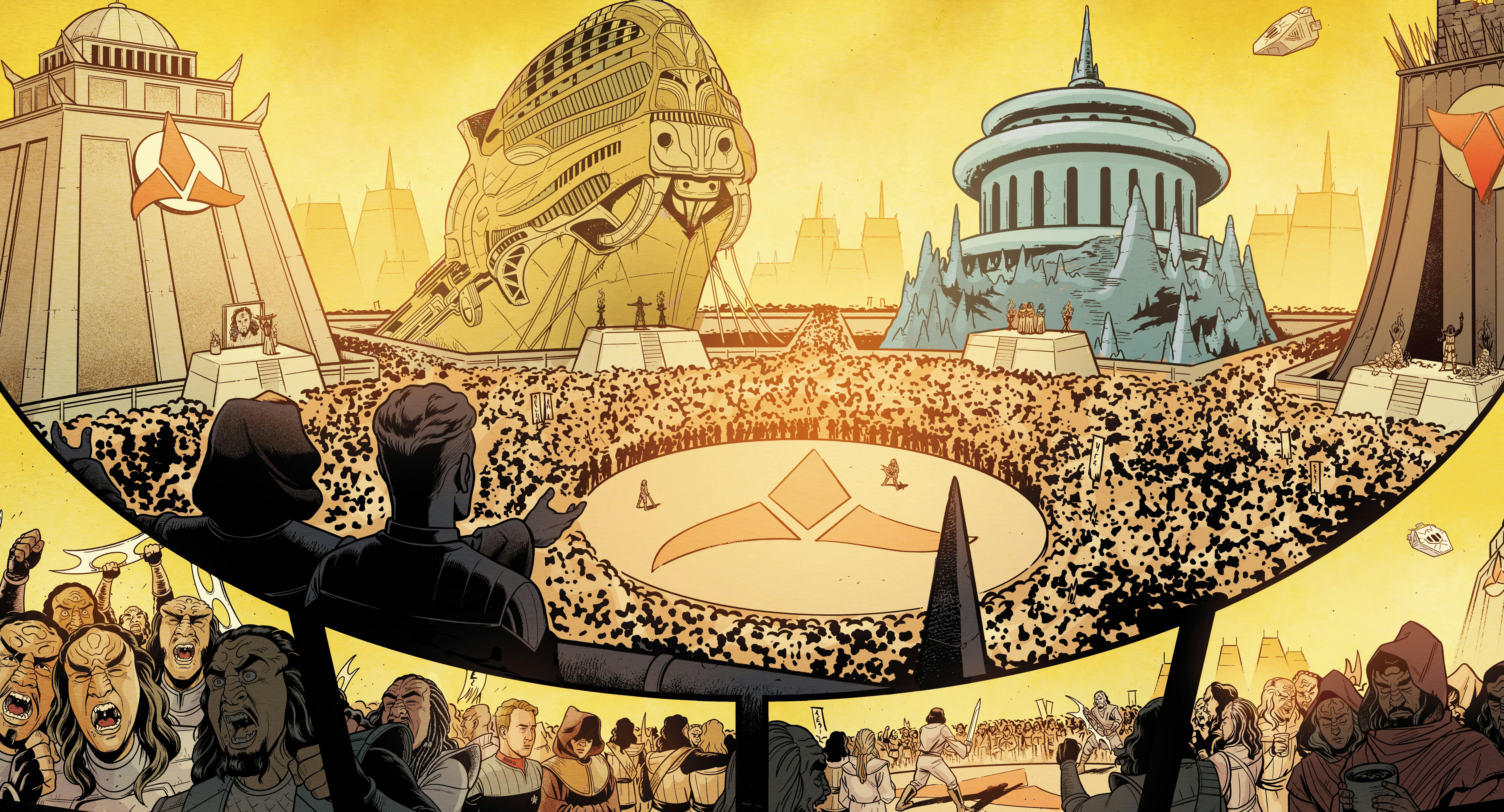
In the first major expansion of IDW ’s bold new Star Trek comic book initiative, which began with the publication of STAR TREK #400 in September 2022 and the launch of an ambitious new flagship series, STAR TREK #1 , in October, IDW in partnership with Paramount Consumer Products is proud to announce the upcoming crossover event STAR TREK: DAY OF BLOOD . This new arc will debut on May 6, 2023, with the short introductory interlude Prelude to Day of Blood , to be included in IDW’s STAR TREK: DAY OF BLOOD Free Comic Book Day special.
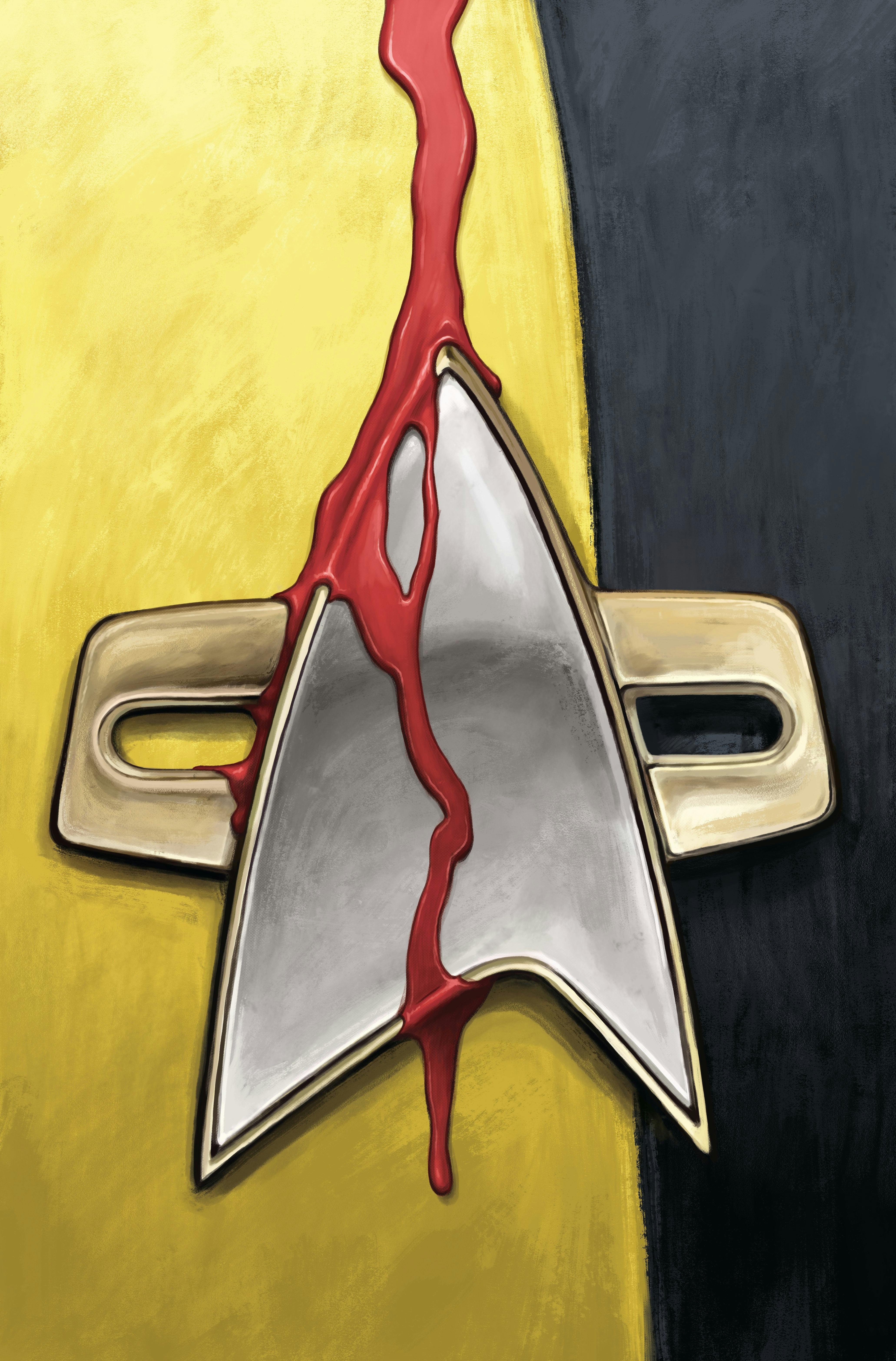
Prelude prefigures the formal kickoff of a sweeping new Star Trek crossover in July that will continue throughout other Star Trek comic book series, including IDW’s ongoing flagship Star Trek series and the recently announced STAR TREK: DEFIANT series , launching in March. Prelude to Day of Blood will be co-written by veteran Star Trek comic creators Jackson Lanzing , Collin Kelly , and Christopher Cantwell with art by Mike Feehan .
In Prelude to Day of Blood , the U.S.S. Santa Cruz travels to the Korvat colony for Kot’baval. But what was supposed to be a simple observation of the sacred Klingon festival quickly turns into a bloodbath when the cult of the godkiller reveals themselves to the universe.

“I’ve been nothing short of ecstatic to be a part of this new, larger Star Trek initiative at IDW,” says Cantwell. “There were moments in our writers’ room with Jackson and Collin where I couldn’t believe we were really doing this — not just telling one Star Trek story but weaving together multiple Trek stories at the same time, with plotlines from STAR TREK and STAR TREK: DEFIANT converging. We threw all our boldest ideas and best character pairings into a story of pure chaos, starship battles, and real epic dramatic resonance you can only achieve in the scope of comics.”
“It’s time for Benjamin Sisko to face the past,” says Lanzing, “and for readers to finally get a look at the true fallout of the Dominion War. Deep Space Nine is the inspiration for this entire line, so it feels only right that the crew of the U.S.S. Theseus come back to where it all started.”
“As lifelong Star Trek fans, Jack and I have been dreaming of this kind of thing since we can remember. This is the kind of event you could only do in comics, with enormous stakes and two starship crews colliding in the middle of a truly deadly crisis. This is our season finale, and it all begins in Free Comic Book Day’s Prelude to Day of Blood .”
“STAR TREK: DAY OF BLOOD is what this last year of comic book planning has been all about,” says senior editor Heather Antos. “It all leads to this moment. Was Sisko the correct choice of the Prophets? Will Worf’s Klingon honor serve him well? Or will the two remain in the crossfires of the godkiller? Jackson, Collin, and Chris are asking some of the biggest questions we’ve ever seen in Star Trek comics, and it’s time to answer them in the franchise’s first-ever classic summer crossover event.”
Ahead of STAR TREK: DEFIANT #1's release in March, get a look at glimpse at the issue with the following unlettered preview:
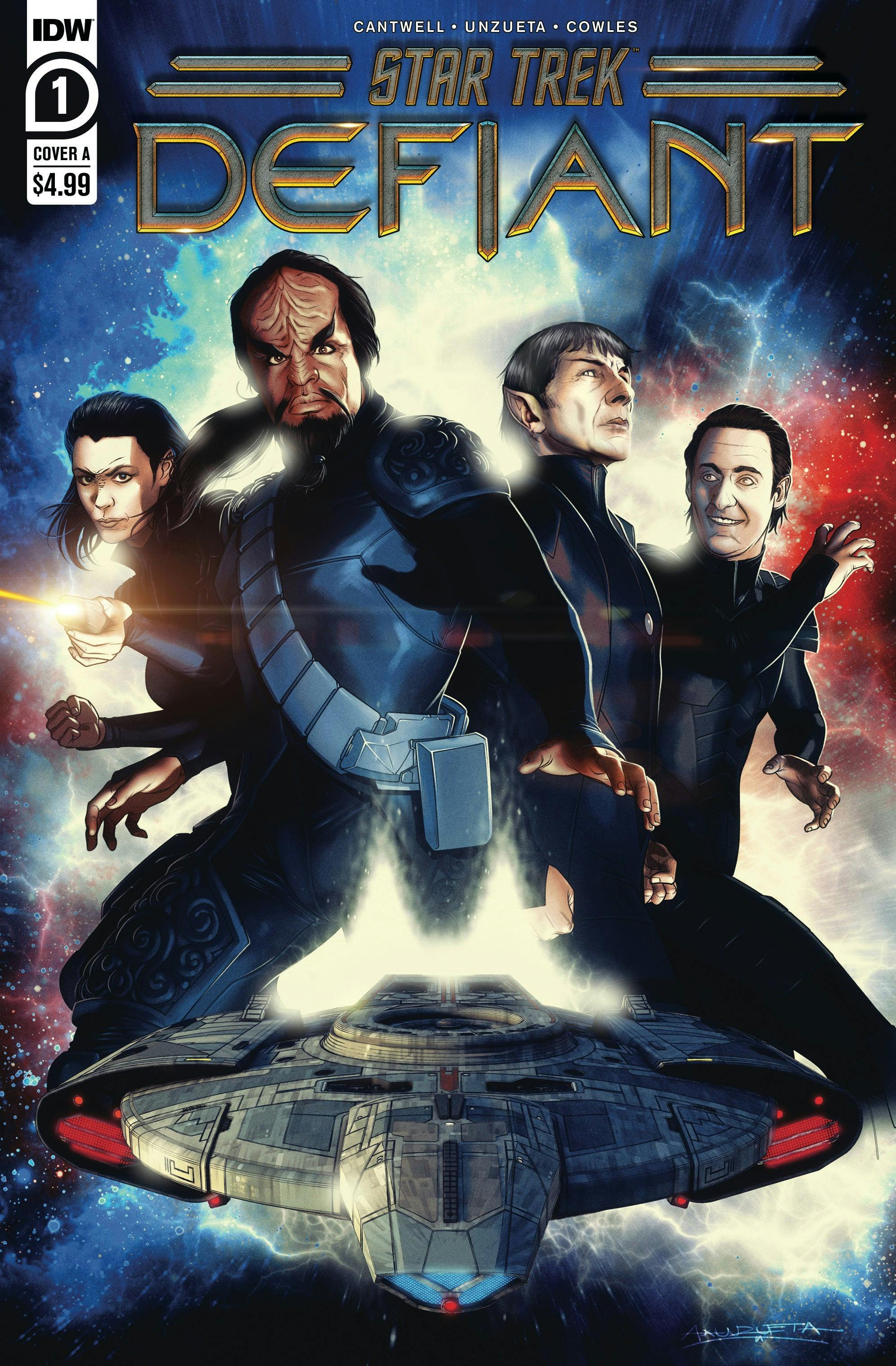
Star Trek: Prelude to Day of Blood will be available as a Free Comic Book Day exclusive on May 6, 2023, and will feature cover art by Malachi Ward.
Following the May FCBD one-shot, the full STAR TREK: DAY OF BLOOD arc will include the following issues:
- STAR TREK: DAY OF BLOOD #1 (July 2023)
- STAR TREK: DEFIANT #6 (August 2023)
- STAR TREK #11 (August 2023)
- STAR TREK: DEFIANT #7 (September 2023)
- STAR TREK #12 (September 2023)
For information on how to acquire copies of Star Trek comic books, please contact your local comic shop or visit www.comicshoplocator.com to find a store near you.
Stay tuned to StarTrek.com for more details! And be sure to follow @StarTrek on Facebook , Twitter , and Instagram .
Get Updates By Email
Watch CBS News
First "Star Trek" comic book sells for record $46,500
By Christopher Brito
November 15, 2022 / 11:52 AM EST / CBS News
The first "Star Trek" comic book sold at an auction for a record-breaking price of $46,500, according to Certified Guaranty Company , a Florida-based comic book grading service.
The comic book "Star Trek No. 1," which was published by Gold Key in 1967, was sold at a Heritage Auctions sale on Nov. 3 .
CGC said it gave the comic book a near-mint rating of 9.6. The company added it has only given the rating to four other copies of the issue, and this one more than doubled the previous record of $20,500 set in 2019.

The inaugural issue contained "The Planet of No Return" and the story was written by Dick Wood. The series' first cover featured Spock, Kirk and Hikaru Sulu, and went on a 12-year, 62-issue run under Gold Key. The series ended in 1979 when Marvel Comics acquired rights to the series and began its own, according to ComicBook . The current license holder of the series is IDW Publishing, which launched its first issue in October.
The history-making book was part of a larger sale of other prized comic books from a collector. Among them included comic books from Walt Disney's Comics, Donald Duck, Scooby-Doo and Astro Boy. Several sold for thousands of dollars.
This sale at Heritage Auctions came days before a rare Buddy Holly poster from "The Day the Music Died" sold for a record-breaking price $447,000. The poster is an original advertisement window card memorializing the show that never was, and one of the first tragedies in rock and roll history.

Christopher Brito is a social media manager and trending content writer for CBS News.
More from CBS News

Military documents contradict GOP congressman's military record claims
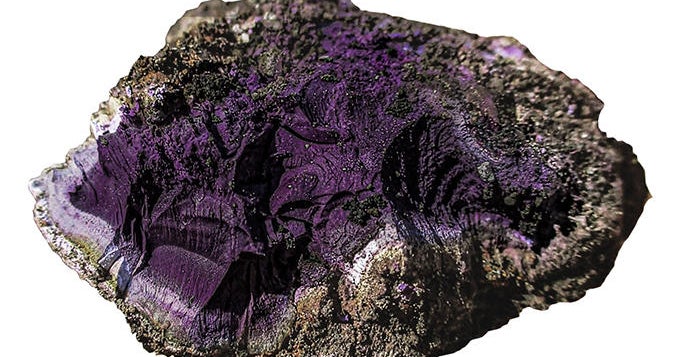
"Incredibly rare" dye that was once worth more than gold found in U.K.

Book excerpt: "You Never Know" by Tom Selleck

"Big Nude Boat" offers a trip to "bare-adise" on a naked cruise
Frequently Asked Questions
Star Trek Comics
Star trek ongoing, star trek: resurgence, star trek: defiant, star trek: picard's academy, star trek: picard - stargazer.
- Create an account
- Pick Theme [Minimize Header] Christmas: Chip & Dale Christmas: Frosty Christmas: Santa Christmas: Rudolph Christmas: W. Woodpecker Adam Strange Anomaly Aquaman Archie Avengers Avengers-70s Batman 1 Batman 2 Betty & Veronica Black Panther Blackhawk Bone Captain America Captain Atom Captain Marvel Casper Cerebus Conan 1 Conan 2 Daredevil Deadpool Defenders Dennis the Menace Doctor Doom Doctor Strange Donald Duck Dragonball Z EC: Vault of Horror EC: Weird Science Fantastic Four The Flash Full Metal Alchemist Galactus Ghost Rider GI Joe Goon Green Arrow Green Goblin Green Lantern Hawkman Hellblazer Hellboy House of Mystery Incredible Hulk Invincible Iron Fist Iron Man Jimmy Olsen The Joker Justice League Legion of Super Heroes Luke Cage Little Lulu Lois Lane Looney Tunes Magneto Master of Kung Fu Moon Knight Nick Fury Our Army at War Phantom The Punisher Rawhide Kid Red Sonja Richie Rich Robin ROM, Spaceknight Romance Comics Scott Pilgrim Sgt. Fury Silver Surfer Spawn The Spectre Spider-Man Submariner Superboy Supergirl Superman Swamp Thing Tales to Astonish Tarzan Teen Titans Teenage Mutant Ninja Turtles Thanos Thor Tomb of Dracula Transformers Walking Dead Watchmen Wendy Western Photo Covers Wolverine Wonder Woman X-Men 1 X-Men 2
- New Releases
- Comic Books
- Value Packs
- How to Sell
- New Listings
- TPBs & Books
- Comic Supplies
- How to Consign
- Vintage Paper
- My Consignments
- Preorders: 35% Off
- My Want List
JavaScript must be enabled to use this site. Please enable JavaScript in your browser and refresh the page.
While supplies last, get one free Free Comic Book Day comic for every $5.00 you buy (excludes subscription service orders).
Auction in progress, bid now! Weekly Auction ends Monday May 6!
Star Trek The Next Generation (1988 1st Series) comic books
- Display Issue list Cover gallery

- Available Stock
Direct Edition. The Enterprise is fired upon by Syntagus Theluv, but the Theluvians insist they've done no such thing in "...Where No One Has Gone Before!" Written by Michael Carlin. Pencils by Pablo Marcos. Inks by Carlos Garzon & Arne Starr. Cover by Bill Sienkiewicz. 38 pages of story. Cover price $1.50.

This item is not in stock at MyComicShop. If you use the "Add to want list" tab to add this issue to your want list, we will email you when it becomes available.
Newstand Edition. The Enterprise is fired upon by Syntagus Theluv, but the Theluvians insist they've done no such thing in "...Where No One Has Gone Before!" Written by Michael Carlin. Pencils by Pablo Marcos. Inks by Carlos Garzon & Arne Starr. Cover by Bill Sienkiewicz. 38 pages of story. Cover price $1.50.
The listings below are from eBay, and MyComicShop is not responsible for these items in any way. Some listings shown here may no longer be available if they sold or were ended by the seller after we last retrieved the listing details.
Clicking on the links to the eBay listings shown above and then making a purchase may result in MyComicShop earning a commission from the eBay Partner Network.

Even on the final frontier, Christmas is celebrated, but everyone aboard the Enterprise has his own way of going about it. Written by Mike Carlin, with art by Pablo Marcos, Carlos Garzon and Arne Starr. Cover by Pablo Marcos and Carlos Garzon. Cover price $1.00.
The listing below is from eBay, and MyComicShop is not responsible for this item in any way. Some listings shown here may no longer be available if they sold or were ended by the seller after we last retrieved the listing details.

The mysterious Q returns and he watches how Picard and company deal with a marauding race. Written by Mike Carlin, with art by Pablo Marcos, Carlos Garzon and Arne Starr. Cover by Pablo Marcos and Carlos Garzon. Cover price $1.00.

The crew of the Enterprise stands divided...and becomes the arena for a battle between Picard and the alien Q. Written by Mike Carlin, with art by Pablo Marcos, Carlos Garzon and Arne Starr. Cover by Pablo Marcos and Carlos Garzon. Cover price $1.00.

"Q Effects!" It's a no-win situation for Picard. If he wins the latest contest of wills with Q, a galaxy will die. If he loses, Q will win the Enterprise. Written by Mike Carlin, with art by Pablo Marcos, Carlos Garzon and Arne Starr. Cover by Marcos. Cover price $1.00.

As the new Enterprise discovers a virtual paradise in space, Data reveals a secret which could plunge its society into a bloody civil war. Written by Mike Carlin, with art by Pablo Marcos, Carlos Garzon and Arne Starr. Cover by Marcos. Cover price $1.00.
Follow us on Facebook

We’ve been selling comics since 1961 (our first sale: Fantastic Four #1 at $0.25, see one of our first ads ) and on the web since 1996.
Read a little about our history.
Copyright © 1996 - 2024 Lone Star Comics Inc. Character images copyright © their respective owners.
- Privacy Policy

Every Star Trek Movie Comic Book Adaptation, Ranked
- Star Trek movie comic book adaptations have been released by various publishers throughout the franchise's history.
- Some of the adaptations took liberties with the original scripts, but still featured awesome and poignant moments.
- The comic book adaptations provide fans with additional scenes and perspectives that were not in the final movies.
Comic books have been an essential component of the Star Trek franchise for most of its history. Publishers such as Gold Key, Marvel, DC and IDW have taken turns with the Star Trek license, giving fans new and exciting adventures in the final frontier. Nearly every incarnation of the franchise has appeared in comic book form, and some publishers have also created original material.
Another component of the Star Trek comic book experience is the movie adaptations. In the 1980s, it was common practice for major publishers to release books adapting popular movies—and Star Trek was one of them. Here are all the Star Trek movie comic book adaptations, ranked.
Star Trek III: The Search for Spock
Published by dc comics, 1984.
Star Trek III: The Search for Spock is arguably the best of the odd-numbered Trek films, but its comic book movie adaptation takes some liberties with the script, namely in the sequencing of events. For example: the comic adaptation begins with the arrival of the USS Grissom at the Genesis Planet, an event that occurred a third of the way through the actual movie. However, the adaptation is not without awesome and poignant moments that did not make it into the final movie, including an epitaph spoken by Edith Keeler in “City on the Edge of Forever.”
Related: 2023 Proved Star Trek's "Deep Space Nine Sequel" More Than Deserves the Name
Star Trek: Generations
Published by dc comics, 1994.
The first Star Trek: The Next Generation movie adaptation would be the last published by DC Comics , as they would lose the license shortly afterward. Fan opinion on Generations remains divided, with its critics pointing to numerous plot holes, such as the Nexus. DC’s adaptation of Generations does not plug any of these holes, but is still an enjoyable read nonetheless. The comic book version of Generations is notable for including a scene not in the original cut of the film, such as Captain Kirk’s orbital sky-dive. While rough cuts of it are now available to watch, for many years this was the only way for fans to see it.
Related: Star Trek vs Alien Crossover Was Meant to Give Picard His Ultimate Challenge
Star Trek IV: The Voyage Home
Published by dc comics, 1986.
Star Trek IV: The Voyage Home is probably the most accessible of the original Trek films: a light-hearted romp with a serious environmental message. The Voyage Home’s comic book adaptation is a faithful one , largely sticking to the original film’s script. Writer Barr adds some dialogue, including a brief exchange between former Enterprise officers Doctor Chapel and Yeoman Janice Rand . Artists Sutton and Villagran are, like Barr, firing on all thrusters here. Star Trek IV: The Voyage Home is widely regarded as one of the best films in the franchise overall, and its comic book adaptation is worthy of the name.
Star Trek: First Contact
Published by marvel comics, 1996.
Star Trek: First Contact is a tense, nail-biting film , and its adaptation reflects that. Published by Marvel as part of their short-lived “Paramount Comics” imprint, Star Trek: First Contact stays faithful to Brannon Braga and Ronald D. Moore’s original screenplay, but is forced to cut some scenes due to spatial limitations. However, this does not deter one bit from the adaptation. Star Trek: First Contact’s movie adaptation was one of a few to receive a reprint years later from IDW, who currently holds the Trek comic license.
Star Trek VI: The Undiscovered Country
Published by dc comics, 1991.
Star Trek VI: The Undiscovered Country was the last ride of the original crew of the Enterprise , a bittersweet end to a glorious run, and its comic book adaptation perfectly captures this tone. Part of the adaptation’s success can be attributed to Peter David , who has written numerous Trek comics and novels, many of which are fan favorites. David and artist Gordon Purcell, who also illustrated a good portion of DC’s Star Trek output, deliver a first-rate adaptation, one that flows just as well as the source film. The Undiscovered Country is one of Trek’s finest hours, and its comic book adaptation is just as good.
Star Trek V: The Final Frontier
Published by dc comics, 1989.
Among fans, Star Trek V: The Final Frontier is regarded as one of the weakest entries in the franchise, but its comic book adaptation shines. Peter David, who had just finished up on DC’s first Star Trek comic, turns in an excellent adaptation that makes the original shine. Drawn by James W. Fry, Star Trek V: The Final Frontier’s comic adaptation hits all the right notes, perfectly distilling the film’s best parts. The comic book version of The Final Frontier was then used to inaugurate DC’s second line of Star Trek comics, which launched shortly thereafter.
Related: 10 Biggest Changes to Star Trek Canon Delivered By Its Epic 'God War'
Star Trek II: The Wrath of Khan
Published by idw, 2009.
Despite being regarded as one, if not the best, Star Trek films, The Wrath of Khan never received a comic book adaptation when it was released in 1982, as Star Trek comics were in limbo at the time, with DC acquiring the license soon after. IDW rectified this problem in 2009, releasing a three-issue adaptation of the movie, which bucked the trend of Trek movie adaptations being one-shots. Thanks to the extra space afforded writer Andy Schmidt and artist Chee Yang Ong, this adaptation shines. Ong’s art especially compliments the movie’s dark tone.
Star Trek: The Motion Picture
Published by marvel comics, 1979.
The modern era of Star Trek comics began with Marvel’s adaptation of Star Trek: The Motion Picture. Initially released as the first three issues of Marvel’s Star Trek comic, The Motion Picture’s adaptation is easily the best of the franchise. Some of its success can be attributed to the legends that worked on it: writer Marv Wolfman and artist Dave Cockrum. Wolfman and Cockrum were on a roll in the late 1970s, and they brought this energy to the adaptation of Star Trek: The Motion Picture . Later released as a one-shot edition by Marvel, the adaptation was reprinted by IDW in the 2000s, giving fans the chance to experience this amazing book again.
The practice of adapting movies to comic book form has largely fallen by the wayside. While the Star Trek movie adaptations may seem relics of a bygone era, they are in fact an important part of the lore.
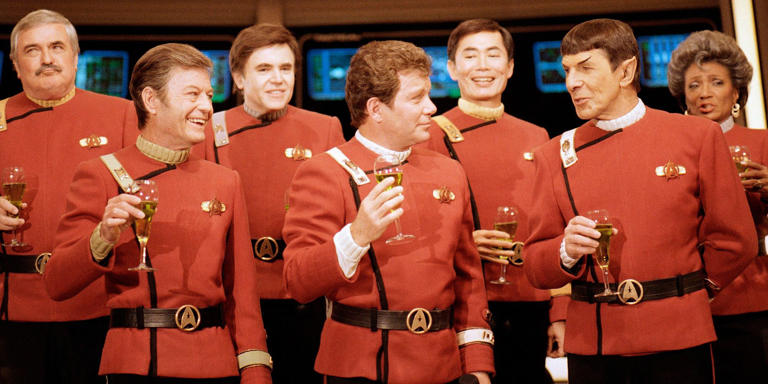

- May 3, 2024 | Michelle Yeoh Receives Presidential Medal Of Freedom
- May 3, 2024 | Chances Of Skydance Takeover Of Paramount Fades; Competing Sony Deal Reportedly Unlikely Too
- May 3, 2024 | Podcast: All Access Listens For “Whistlespeak” With Commentary From Mary Wiseman Of ‘Star Trek: Discovery’
- May 2, 2024 | Recap/Review: ‘Star Trek: Discovery’ Goes On A Spiritual Journey In “Whistlespeak”
- May 1, 2024 | Toronto Stage Used For ‘Discovery’ Renamed “The Star Trek Stage” By Pinewood Studios
Star Trek Event Coming To ‘World Of Tanks’ Online Game – Watch Mission Preview
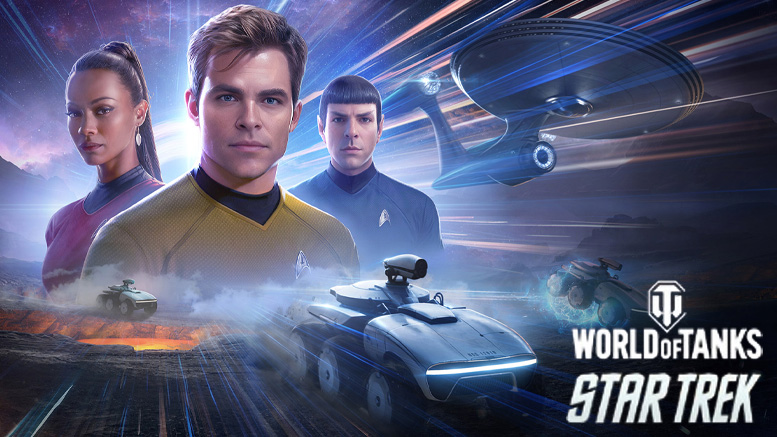
| May 1, 2024 | By: TrekMovie.com Staff 19 comments so far
The popular World of Tanks massive multiplayer online game is usually all about tank warfare, but they just announced a game event that will let you compete in Starfleet “rovers.”
Call to the Final Frontier
The “Call to the Final Frontier” event will run in World of Tanks from May 2 to May 13. It is themed around the 2009 Star Trek movie and Kelvin Universe. Here is the mission synopsis:
A mysterious alien Object stole the antimatter straight from the warp core of the U.S.S. Enterprise. Use your vehicle combat skills while competing with other crewmates to recover the antimatter and research the alien Object. Help the iconic flagship resume her five-year mission!
For the special event players put aside their usual tanks to drive rovers to collect antimatter fragments to get Star Trek-themed rewards. Players can compete in daily event missions to earn new styles, decals, inscriptions, and 3 new Commanders with unique voices (Kirk, Spock, and Uhura). There is also a special “Orion Lockbox.”
This video provides your mission briefing…
Trekify your Tank!
One of the 3D styles you can get during the event is called “Emissary,” transforming your regular tank with a Starfleet theme. Here is the teaser from World of Tanks :
“Found this one when we were looking for that T95 we lost during field trials. The ground ’round the thing was…strange, wrinkled. Like it had been fried or something. And what a remarkable piece of equipment, this tank. Looks a bit like one of ours, right? But I heard Doc getting all excited about the ‘improbable alloy’ it’s made of—after he managed to chip a bit off the lower plate. Hope his ravings can stir up some of the top brass to get the tank outta our depot and into some fancy top-secret lab. Because I’m telling you, it looks like it can fly—or even more. You know, the little green men that built it—just for fun, inspired by our exotic designs—they might find its remote control and press some buttons.”
Check it out…
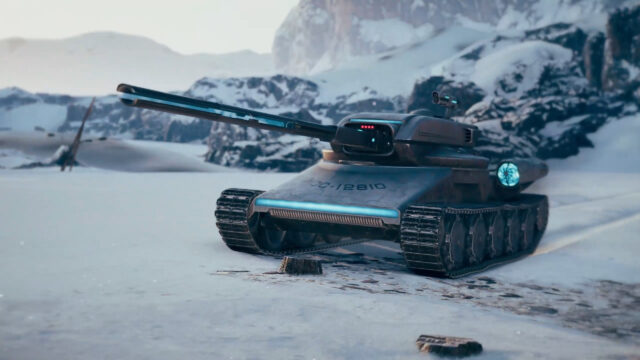
For more info on the Star Trek event or to start playing World of Tanks visit worldoftanks.com .
Related Articles
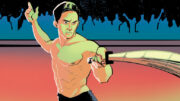
Comics , Discovery , Kelvin Universe , Lower Decks
Exclusive First Look At Artwork From ‘Star Trek: Celebrations’ – IDW’s One Shot Comic For Pride Month
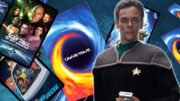
Collectibles , DS9 , Games , Lower Decks , TNG
Star Trek Merch: TNG And ‘Lower Decks’ CCGs Announced, Dr. Bashir 12″ Figure Revealed, And More
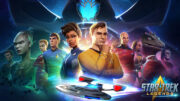
‘Star Trek: Legends’ RPG Game Launches On PC With New Exclusive Content

Electronics/Gadgets , Feature Films (TMP-NEM) , History , Merchandise , Star Trek Universe TV , Trek on TV
‘The Archive’ Star Trek Spatial Experience Released For Apple Vision Pro
scrolled down and legit thought for 1 second that ST4 was being announced with surprise new movie poster
Isn’t that the Enterprise-A from the end of Beyond? That’s an interesting choice to use in the marketing for this.
They use the first Kelvin-prise at the beggining of the video, then they change it at minute 1 with the Kelvin-prise A.
This seems pretty silly. It would be nice to get a single player adventure game, but I’ll keep on dreaming. Star Trek: Resurgence isn’t terrible, but it’s not the open world exploration RPG I’d rather fawn over.
My two complaints for Resurgence are that the “video game-y” parts of like the little mini games or flying the ship are a bit clunky, and that also sometimes, for me personally, it goes just a little too far on the lets put you in stressful situations sort of thing (I know that’s kind of the point of the game, so that probably is just part of it and not much to do about that but it just felt like it was constantly trying to make me feel bad about making choices). But in terms of getting to feel like you are part of an interactive Star Trek story they did a wonderful job with the look and feel and lots of great writing.
If there’s one thing that makes me thinks of Star Trek, it’s heavy artillery.
Agreed, was just about to post this sentiment.
I’m at a loss to explain why this was greenlighted. Star Trek… with military tanks? Someone was asleep at the wheel.
I’d surely hate to think that during the Dominion War that when it came to ground forces that the Klingons did all the heavy lifting.
The same logic that had Starfleet borrowing a Romulan cloaking device for the Defiant instead of developing their own: let others do the distasteful work so we can keep our hands clean.
they’ve also done collabs with TMNT, it’s not meant to be treated as some super serious in universe Trek event
the reaction to this event is so overblown and silly, IP crossover collabs are the current “it” thing for big online games
Star Trek New Worlds
At long last, the next Transformers and Trek crossover I was waiting for.
Age Of Tanks paid a licence fee…
Enjoy the game kids because this is probably the only thing you will get to getting more JJ verse. It certainly won’t be another movie at the rate things are going. 😂
…another mismanagement of the franchise, imo. Imagine if Rockstar put out a Trek game, aka RDR/GTA.
It’ll never cease to amaze how big an influence Mass Effect has had, not just on games, but on sci-fi in general.
You’re right, those tanks totally look like they’re straight out of Mass Effect
Brought to by the same brilliant folks who put Wrestling on the SciFi Channel.

IMAGES
COMMENTS
From 1969 to 1971, a series of weekly Star Trek comic strips ran in the British comics magazine TV21. 105 issues were produced, as well as various annuals and specials. All were original stories. Two more annuals, under the Mighty TV Comic banner, also produced original Star Trek materials. Later, the weekly TV Comic also reprinted serialized ...
Star Trek. From February 1984 through February 1996, DC Comics held the license to publish comic books based upon the Star Trek franchise, namely Star Trek: The Original Series (TOS) and Star Trek: The Next Generation (TNG). The main DC Comics Star Trek title was published in two series, comprising 136 issues, 9 annuals, and a number of special ...
Star Trek is a series of comics based on the Gene Roddenberry television series Star Trek and the subsequent films. From February 1984 through February 1996, DC Comics held the license to publish comic books based upon the Star Trek franchise, namely Star Trek: The Original Series and Star Trek: The Next Generation. The main DC Comics Star Trek title was published in two volumes, comprising ...
A guide to Star Trek comics and graphic novels published in the United States and elsewhere with brief plot summaries and cover images (or more than you ever needed to know about Star Trek comics). This site is maintained by Mark Martinez, whose obsession with Star Trek comics has gotten way out of hand.
Gold Key Comics published 61 issues from July 1967 to February 1979. The comics focused on the USS Enterprise during James T. Kirk 's first five-year mission. A 62nd issue was written and partially illustrated, but was only published in 2020, when Eaglemoss published it in the Star Trek Graphic Novel Collection .
Comic book version of the original Star Trek TV series that starred William Shatner and Leonard Nimoy. 90210-708. Painted cover art. "Mr. Oracle," script by Arnold Drake, art by Alden McWilliams; Spock must become a living god, or an entire civilization will die! 36 pgs., full color. $0.30.
STAR TREK 1 6.5 DC 1984 JL. $40. *STAR TREK* First Edition! George Perez Cover, DC (1984), VF, Bagged & Boarded. 3 days left. Auction STAR TREK #1 George Perez cover - DC COMICS 1984. 5 days left. Auction STAR TREK 1st Star-Spanning Collector's Issue Barr/ Sutton/Moore FEB 84 + 2 More. 3 days left.
The first story in this series takes place after the events of Star Trek II: The Wrath of Khan. Spock is dead, and Saavik has replaced him as science officer. Part one of a four-part story arc. Writer: Mike W. Barr. Penciller: Tom Sutton. Inker: Ricardo Villagran. Cover artist: George Perez. #2 Mar 1984.
When the show was canceled at the end of the 1960s, fans of Star Trek were left with little of their favorite franchise to enjoy.To fill that void, publisher Gold Key Comics produced a monthly Trek series that presented the further adventures of The Original Series. Though canonically ignored today, the Gold Key stories are recognizably Star Trek, and feel like lost episodes of the show.
Star Trek: The Original Series - Star Trek #24 and #25. DC Comics held the license to publish Star Trek stories from 1984 to 1996. DC's main title was Star Trek, published in two series (the first one is set after Star Trek II: The Wrath of Khan and the second after Star Trek V: The Final Frontier), comprising 136 issues, nine annuals, and ...
In fact, the very first Star Trek comic book began in 1967, at the end of the original series's very first season. This first series was published by Gold Key, an imprint of Western Publishing founded only five years before, in 1962. Gold Key experimented with the comics format, initially using rectangular word balloons and thought bubbles ...
CGC STAR TREK 1 Gold Key Comic 1971 CGC 4.5 Pinup Back First Star Trek Comic: $400 Star Trek #1 Fine (6.0) Gold Key 1967, Shatner & Nimoy photo covers: $425 Star Trek #1 (1967) CGC 6.0 R OW to WHITE PAGES Gold Key 1st Star Trek Comic: $500 Star Trek #1 - Gold Key Comics - 1st issue and Star Trek Grail!!! $700
While Star Trek is currently entering a brand new era for its comics, one fan spent a record-second sum to own a piece of Star Trek's comic book history.A copy of Star Trek #1 -- originally ...
IDW is proud to announce a bold new direction in Star Trek comics, beginning with a brand-new flagship ongoing series that goes where no one has gone before! Debuting in October 2022, STAR TREK #1 features art by Ramon Rosanas ( Marvel's Star Wars, Ant-Man ), and scripts by Collin Kelly and Jackson Lanzing, the creative team behind Star Trek ...
In the first major expansion of IDW's bold new Star Trek comic book initiative, which began with the publication of STAR TREK #400 in September 2022 and the launch of an ambitious new flagship series, STAR TREK #1, in October, IDW in partnership with Paramount Consumer Products is proud to announce the upcoming crossover event STAR TREK: DAY OF BLOOD.
The comic was followed by the spin-off comic Star Trek: Defiant, where Worf leaves Sisko's crew and creates his own one. It is also a roster of characters from many series, including an aged Spock from the original series. Both series made the first comic-book crossover of the Star Trek franchise, Day of blood.
The Uplift: A "Star Trek" trailblazer and Markelle the Gazelle 23:34. The first "Star Trek" comic book sold at an auction for a record-breaking price of $46,500, according to Certified Guaranty ...
Star Trek: Discovery #1. AUG170484 (W) Mike Johnson, Kirsten Beyer (A/CA) Tony Shasteen Warp into adventure with this new comic book series that ties into the new Star Trek television show ...
World-renowned comic book and graphic novel storytelling, including Locke & Key, Sonic The Hedgehog, Star Trek, Teenage Mutant Ninja Turtles, Godzilla, My Little Pony, and more!
At NYCC, IDW announced a new miniseries titled Star Trek: The Sons of Star Trek which launches in January 2024. The series is being written by Morgan Hampton, who is new to Trek comics, and ...
Star Trek The Next Generation (1988 1st Series) #6. Published Jul 1988 by DC . As the new Enterprise discovers a virtual paradise in space, Data reveals a secret which could plunge its society into a bloody civil war. Written by Mike Carlin, with art by Pablo Marcos, Carlos Garzon and Arne Starr.
Star Trek: The Next Generation: Enemy Unseen, first printed in 2001 (ISBN 1-56389-765-2), contains mini-series Perchance to Dream and The Killing Shadows, and one-shot "Embrace the Wolf". The book features a painted cover by Drew Struzan, is edited by Jeff Marriotte and designed by Amber Bennett. References
IDW has announced all of their Star Trek comics coming in May and the first issue of the just-announced Star Trek: ... New May 2023 Star Trek comics. Star Trek: Defiant #3 (May 10 - $4.99) ...
Star Trek IV: The Voyage Home is probably the most accessible of the original Trek films: a light-hearted romp with a serious environmental message.The Voyage Home's comic book adaptation is a ...
The "Call to the Final Frontier" event will run in World of Tanks from May 2 to May 13. It is themed around the 2009 Star Trek movie and Kelvin Universe. Here is the mission synopsis: A ...
By Jamie Lovett - May 3, 2024 04:15 pm EDT. 0. Sylvia Tilly, played by Mary Wiseman, has been on a long character journey during Star Trek: Discovery 's five seasons on Paramount+. She started in ...